#that ukraine was under polish-lithuanian rule
Explore tagged Tumblr posts
Text

@claudia-de-lioncourt No no speak up, you're right and you should say it. Gabrielle de lioncourt is in the room with us right now and she might have some words too lol

@black-market-wd4o ah but dont forget... Marius thinks of himself as "sharing the wealth"! He's just helping civilization and art along by harnessing the talent of wasted youth! Amadeo is once again not very impressed.


@platoapproved You're 100% correct and let us not forget why Marius (cough Anne Rice cough) is so racist towards Armand! Let's see why ukraine keeps being depicted as less european and more backward than the rest of eastern europe throughout the book -Marius tells us right here, dimissing Amadeo's all in all quite reasonable lack of faith in the society that enslaved and abused him:

Ah. The Mongol invasions. Right. Thats when it became a dark and savage land. Gotcha. Hey quickly Marius what are your opinions on Fortress Europe.
Like look at this

"See Amadeo I care about REAL working men... bankers and merchants" bdjwjdkfbfjf
Also the absolute clownery of saying that last line to the boy he bought from a brothel. I don't care that he ends up wanting to send him to university or whatever, he admits himself that amadeo was not supposed to have any options but to be his to mold. No shit Armand feels discouraged.
#the white supremacy JUMPS out lol#listen im iranian#'we used to have a golden age where we were better and whiter but then the evil mongols/arabs invaded us'#is literally the bullshit co constructed western/pahlavi mythos about iran#(of course it goes further in the past than that with montesquieu coining persia as the og orientalist construct etc etc but you know)#iwtv#i KNOW marius is going around sprouting bs about fortress europe#he probably loves the EU#i need to kill him#not even touching upon the fact that anne rice fully bought into russian imperialism like hey#kiev rus was not a thing back then and she KNOWS this bc shes somehow aware#that ukraine was under polish-lithuanian rule#and yet she never writes the word ukraine + maintains that Warsaw is in russia#its not pure ignorance i do believe that to her its All Russia Anyway
94 notes
·
View notes
Text
VILNIUS, Lithuania — A DHL cargo plane crashed on approach to an airport in Lithuania’s capital and skidded into a house Monday morning, killing a Spanish crew member but not harming anyone on the ground. The cause of the accident is under investigation.
A surveillance video showed the plane descending normally as it approached the airport before sunrise, and then exploding into a huge ball of fire behind a building. The moment of impact could not be seen in the video.
The crash occurred at a time that Western security officials suspect that Russian intelligence is carrying out sabotage against their nations in retaliation for their support for Ukraine — including arson attacks, disinformation and by putting incendiary devices in packages on cargo planes.
In July one caught fire at a courier hub in Germany and another ignited in a warehouse in England.
Polish prosecutors said last month that parcels with camouflaged explosives were sent via cargo companies to EU countries and Britain to “test the transfer channel for such parcels” that were ultimately destined for the U.S. and Canada.
Lithuanian officials acknowledged that one line of inquiry will be whether Russia played a role given its suspected involvement in other cases of sabotage — although they stressed that there is no evidence pointing to that yet.
“Without a doubt, we cannot rule out the terrorism version,” said Darius Jauniškis, chief of Lithuanian intelligence.
“We see Russia becoming more aggressive,” he said. “But for now, we really cannot make any attributions or point fingers at anyone, because there is no information about it.”
The Lithuanian airport authority identified the aircraft as a DHL cargo plane arriving from Leipzig, Germany, a major freight hub, and one of the injured was a German citizen.
The German transportation ministry said that experts from the German Federal Bureau of Aircraft Accident Investigation would be sent to Lithuania to help with the investigation. Officials there also cautioned against trying to draw conclusions before all the evidence has been examined.
“No statements can yet be made about the cause of the accident. Whether it was an accident or whether another cause led to the crash of the cargo plane is the subject of the current investigation,” German Interior Ministry spokesperson Mehmet Atta said at a briefing in Berlin.
The head of Lithuania’s firefighting service said that the plane skidded a few hundred meters (yards), and photos showed smoke rising from a damaged structure in an area of barren trees.
“Thankfully, despite the crash occurring in a residential area, no lives have been lost among the local population,” Prime Minister Ingrida Šimonytė said after meeting with rescue officials.
Rescue workers sealed off the area, and fragments of the plane in DHL’s trademark yellow could be seen amid wreckage scattered across the crash site.
The cargo aircraft was carrying four people when it crashed at 5:30 a.m. local time. One person, a Spanish citizen, was declared dead and the other three crew members — who were Spanish, German and Lithuanian citizens — were injured, said Ramūnas Matonis, the head of communications for Lithuanian police, in an email.
The DHL aircraft was operated by Swiftair, a Madrid-based contractor. DHL said in an emailed comment that the plane “made a forced landing” about a kilometer (half a miles) from the Vilnius airport, adding: “The cause of the accident is still unknown and an investigation is already underway.” Swiftair did not comment.
“Residential infrastructure around the house was on fire, and the house was slightly damaged, but we managed to evacuate people,” said Renatas Požėla, chief of the Fire and Rescue Department.
One eyewitness, who gave her name only as Svaja, ran to a window when a light as bright as a red sun filled her room and she heard an explosion, followed by flashes and black smoke.
“I saw a fireball,” she said. “My first thought is that a world (war) has begun and it’s time to grab the documents and run somewhere to a shelter, to a basement.”
Laurynas Kasčiūnas, the Lithuanian defense minister, said “there were definitely no external factors that could have damaged the plane.”
“We can clearly see that,” Kasčiūnas said. “However, to find out what happened inside the plane, it will be necessary to interview the surviving crew members. And of course, the black box. That will take some time.”
Flight-tracking data from FlightRadar24, analyzed by the AP, showed the aircraft made a turn to the north of the airport, lining up for landing, before crashing a little more than 1.5 kilometers (1 mile) short of the runway.
Weather at the airport was around freezing at the time of the crash, with clouds before sunrise and winds around 30 kph (18 mph).
The Boeing 737 was 31 years old, which is considered by experts to be an older airframe, though that’s not unusual for cargo flights.
The prime minister cautioned against speculation, saying investigators needed time to do their job.
“The responsible agencies are working diligently,” Šimonytė said. “I urge everyone to have confidence in the investigating authorities’ ability to conduct a thorough and professional investigation within an optimal timeframe. Only these investigations will uncover the true causes of the incident — speculation and guesswork will not help establish the truth.”
3 notes
·
View notes
Text
Republic Of Many Nations - Historical Opportunity for Central/Eastern Europe?
(This is a translation of an exhibition created with the cooperation of multiple Slovak and Polish institutions for the study of history that hanged in the corridors of University of Prešov in late 2023. Consider this an introduction to Rzeczpospolita for all my 1670 girlies. It's heavily biased in favor of Rzeczpospolita, luckily in ways that are neither subtle, nor do they detract from its informational value. I am leaving out most of the pictures and the commentary under them, as well as the quotes included - simply because I couldn't fit them into the format of a tumblr article. The notes bellow in [] brackets are mine, the rest of the text is from the exhibition itself, and the pictures, or something close to them - like the same building from a different angle - appeared on the exhibition panels as well. Commentary on the pictures is also from the exhibition.)
***
Did you know that from the end of the 14th century untill the end of the 18th century a unique republic existed in what is now Poland, Lithuania, Ukraine and Belarus, which was the biggest state in Europe and which wasn't founded by military expansion, but by a peaceful alliance of Kingdom of Poland and Grandduchy of Lithuania? This republic gradually fell to the pressure of surrounding absolutist monarchies led by the Tsardom of Muscovy [1], but its legacy persists in the ethos of civil liberties, democratic participation and diversity. Legacy of this republic has become a part of the identity of nations in the Middle/Eastern Europe, which for more than two centuries resisted Russian imperial rule and which cling to these values to this day.
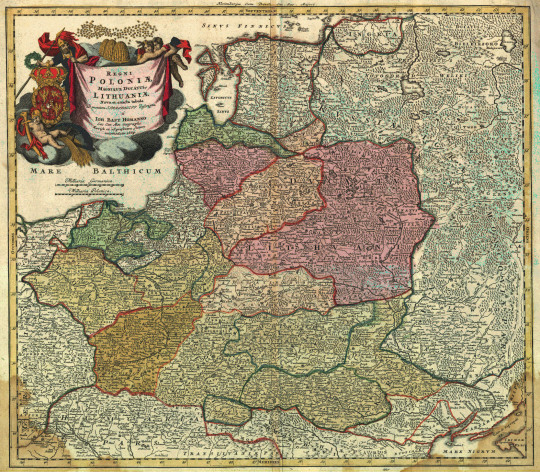
1.) REPUBLIC OF MANY NATIONS The beginings of the "republic of many nations" can be traced to the year 1385, when the hand of Jadwiga, heir to the Polish throne, was offered to Jogaila, the Grand Duke of Lithuania, with the stipulation that he should become a Christian. When Jogaila ascended the throne of Poland as Władisław II. Jagiełło, it created a dynastic link between Poland and Grandduchy of Lithuania, which besides Lithuania consisted of lands in today's Belarus and Ukraine. When on the 1st of July 1569 in the Lublin Castle Polish nobility agreed to extend their privileges to the Lithuanian nobility in exchange for Lithuania ceding large territories to the Polish crown, an agreement was born, on the basis of which a dynastic union transformed into a commonwealth, now called Rzeczpospolita, i.e. The Republic. Though initially the union of these polities was motivated by the existence of common enemies - the Teutonic Order and later Russia - the strongest bond between them turned out to be the unique arrangement established by the Polish and Lithuanian representatives. The "Republic" in the name of this polity was supposed to demonstrate that the Commonwealth would be ruled by its noble citizens regardless of whether their mother tongue was Polish, Lithuanian or Ruthenian (common ancestor of Rusyn, Belarussian and Ukrainian). Though Republic was for hundreds of years plagued by numerous internal issues, and by the end of the 18th century it was destroyed by the aggression of its neighbours, in 1791 citizens managed to approve a unique document - Constitution of 3 May 1791, now considered the first modern constitution in Europe...
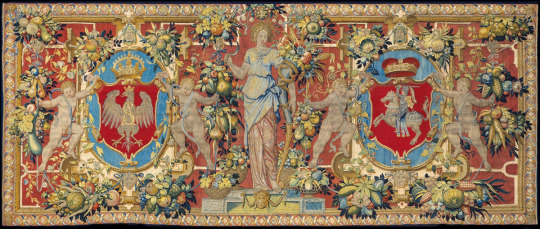
2.) STORY OF THE CROWN AND THE GRANDDUCHY Even after the Union of Lublin, the Polish Crown and Grandduchy of Lithuania were still separate states, just like they used to be for hundreds of years before that. After all, the rulers of Poland had their own archbishopric and royal title since the early 11th century, struggling for power against the likes of Přemyslids, while the grand dukes of Lithuania, attempting to revive the legacy of Kievan Rus', still hesitated whether to accept baptism from Rome or Constantinople. While many of the differences between them disappeared after the creation of Polish-Lithuanian Commonwealth, as the Lithuanian estates adopted the lifestyles of Polish nobility, the grandduchy continued to have their own legislature in the form of so-called Lithuanian Statutes, as well as their own army and finance, and a strong sense of self-determination. However, the connection between Lithuanian and Polish society was very strong - in October 1791, shortly before the final occupation of the Republic by the Prussians, Russians and Austrians both Polish and Lithuanian representatives agreed upon The Mutual Vow Of Both Nations [2], in which they promised that the story of Rzeczpospolita should continue in perpetuity as an indelible federation of the two countries...
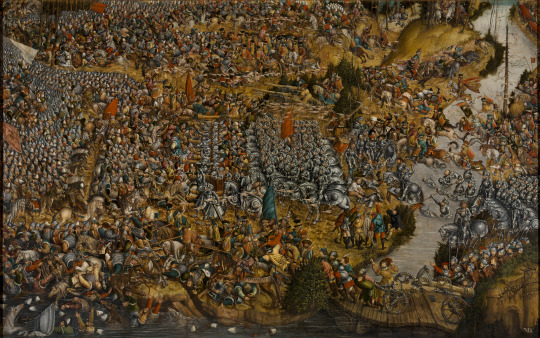
3.) THE STORY OF UKRAINE: A MISSED OPPORTUNITY FOR THE REPULIC? While its name points to a country "somewhere on the edge", Ukraine was a tempting target for many powers since the Middle Ages. After the fall of Mongolian Golden Horde in the 14th century, it was, as the former core of Kievan Rus' added to Lithuania, which presented itself as a continuation of this great Kievan empire. In this way, Lithuania came into the crosshairs of Muscovy, which held similar aspirations. After 1569 the Commonwealth of Poland-Lithuania, which in many ways respected the distinct Ukrainian identity and unlike Moscow didn't consider it to be just a branch of the Russian nation, became its protector from the Muscovite incursion into Ukraine. Even the Polish-Lithuanian nobility living in Ukraine identified and called themselves "Ruthenians", and Grand Duchy of Lithuania used so-called Ruthenian as its official language. Cossacks living in the Wild Fields in the Dnipro river basin, who on the one hand didn't accept the autority of Polish-Lithuanian nobility, on the other hand helped to safeguard the borders of Rzeczpospolita from Moscow and the Ottomans, were also bearers of the sovereign Ukrainian identity. In the middle of the 17th century dissatisfaction of the Cossacks with certain magnates and issues of religion grew into the bloody uprising of hetman Bohdan Khmelnytsky, who in 1654 turned to the Muscovite tsar [1] with a plea for protection. However, among the Cossacks, critical voices towards Moscow could also be heard, especially the voice of Ivan Vyhovsky, who in 1658 made a deal with the Commonwealth of Poland-Lithuania about its transformation into the Republic of Three Nations with a coequal position of the Grand Duchy of Russia [3] and orthodoxy. Because of the opposition from a portion of nobility, Cossacks and Moscow, the agreement never went into effect, and thus both the Republic and Ukraine missed their historic chance...
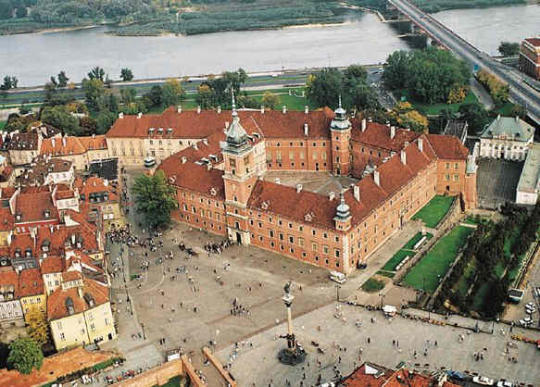
4.) KING IS THE FIRST AMONG US, THE FIRST AMONG EQUALS The creation of Polish-Lithuanian Commonwealth was also a key flashpoint for the transformation of royal power. Since Polish king Sigismund II. August, who thanks to the Union of Lublin became the ruler of Rzeczpospolita, died in 1572 without issue, Polish-Lithuanian nobility in accordance with the original agreement established the viritim election principle, according to which every noble present could elect their own king on special convocational sejms (diets). Ruler elected in this manner had to confirm noble privileges trough the so-called Henrician Articles and a collection of vows Pacta Conventa. Ruler's political power was thus perpetually subject to the rule of law (lex regnat non rex), and if the nobility deemed the ruler's actions unlawful, they could in the case of an emergency even call up a confederation and declare armed resistance. Thus, from then on until the acceptance of Constitution of 3 May 1791, the election of Polish-Lithuanian monarch became subject to the interests of foreign dynasties and local magnate houses. In the 18th century, an era during which the surrounding countries mostly adopted absolutism, the weakness of royal power came to be seen as the fundamental reason for the political decline of the Republic.
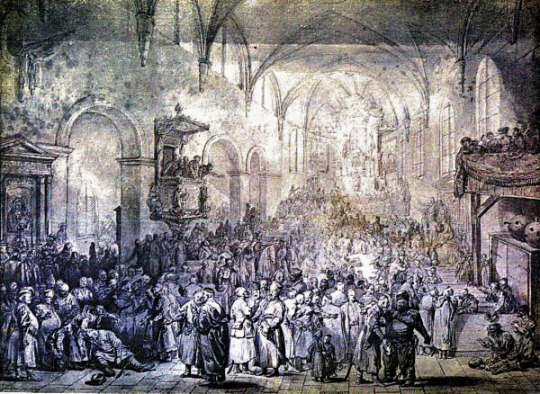
5.) NOT A MONARCHY, NOR AN ARISTOCRACY, NOR A DEMOCRACY The name Rzeczpospolita (the Republic) wasn't chosen for the Commonwealth of Poland-Lithuania by accident. Polish-Lithuanian nobility actually believed that their country can revive the lost ancient legacy of the just polities, and so they considered their Rzeczpospolita, to which they had given the epithet "most serene" [2], to be the third real republic in human history (after the Roman and Venetian ones). Members of the Polish nobility, who were convinced that the noble station brings with itself the duty of civic virtues, thus positioned themselves as the new Aristotles, and considered the so-called mixed constitution, which combined virtues of the monarchy, aristocracy and rule of the people, to be the best way to organize the state. Power in Rzeczpospolita was thus divided between the elected king, the Senate consisting of highest state officials, and a chamber of noble-born representatives, who could use the later infamous liberum veto [4], or the right of individual protest, which especially in the 18th century severely hampered the flexibility of the Republic. However, in the Republic, a specific form of political decisionmaking wasn't practiced only by the parliament of nobles. In Ukraine, the Zaporozhian Cossacks created a very peculiar form of military democracy. In their fortified camps (sietches [2]) the sietch councils formed by direct election, and they in turn elected their military commanders (atamans) and government officials, made decisions about war and piece, economic policy, even legal judgements.
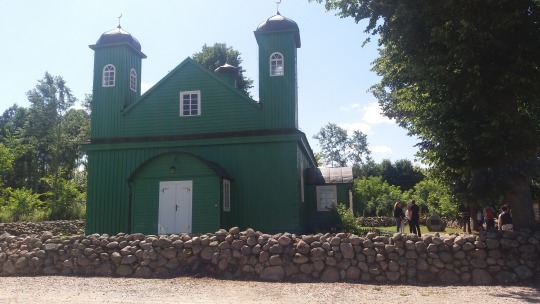
6.) DIFFERENT FAITHS LIVE TOGETHER WITHOUT NEED FOR BORDERS Calling the ancient Republic "Polish" might be misleading, because today the epithet "Polish" is tied mostly to the ethnic nation. However, since in the Polish-Lithuanian Commonwealth, the nation was the nobility, which based its honour on citizen loyalty towards the common polity inspired by antiquity, the noble "nation" at the time included all members of the class no matter the country they were born in, language they spoke, or the faith they professed. That's why, concerning the question of self-perception in the period, we often see the phrase "I am of the Polish nation, but of Ruthenian birth." This citizenship-based definition of Polish identity was closely related to the unprecedented religious tolerance, as codified in 1573 by the so-called Warsaw Confederation. The fact that the noble "nation" included not only Catholics, Lutherans, Calvinists, Uniates and Orthodox Christians, but Mennonites and Arians, led to Rzeczpospolita being called "a state without stacks", because the foreigners there didn't end up burned at a stake, but finding a refuge. However, in the 18th century, this fragile coexistence of different denominations was severely disturbed, because the neighbouring great powers loved to use the rights of religious minorities for their own ends. In the 3 May 1791 constitution, all faiths were thus tolerated, but the Catholicism was supposed to be the state religion.
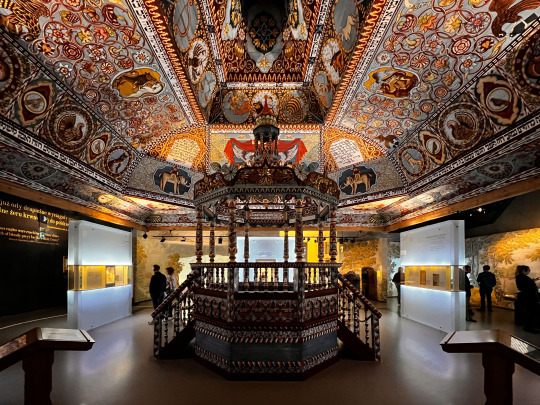
7.) POLONIA PARADISUS JUDAEORUM While the Jewish people were often banished from the rest of medieval European countries, kings of Poland granted many privileges to the arriving Jews. That being not just The Great Charter of Jewish Rights [2] from 1264, but also Privilegia de non tolerandis Christianis, which allowed Jewish merchants to settle in designated communities without Christian competition. Jews gradually gained the right to their own local administration (so-called kahalas) and around the time of the Union of Lublin even to summon their own parliament, called the Diet of the Four Countries [2] (also known as Va'ad). It is therefore no wonder that in the 16th century Europeans started to call Rzeczpospolita "Jewish paradise" and that three quarters of the entire Jewish population of the world lived here. This peaceful coexistence started to suffer in the middle of the 17th century, mainly because of Cossack uprisings, during which thousands of Jews were massacred for being alleged allies of the nobility, while in the 18th century the country experienced general decline in religious tolerance. However, as part of the attempt to save the Republic during the so-called Great Sejm [2] of 1788-1792, a special commission was created to designate the position of Jews within Rzeczpospolita. And when the famous Kościusko uprising defending the independence of Rzeczpospolita and the legacy of the Constitution of 3 May 1791 against the Russian invasion broke out, many Jews didn't hesitate to join the first Jewish regiment and fight in battle for the Republic.

8.) WALLS OF CHRISTIAN EUROPE Noble citizens didn't perceive their Republic as just an embodiment of ancient community, but also a military power. That's why the nobility placed so much value on military virtues and in emulation of ancient Sarmatians, whose descendants they considered themselves to be, they also relied heavily on elite cavalry - the winged hussars, whose exotic appearance and military prowess gained them respect on the battlefield. Polish-Lithuanian nobility, convinced of the exceptional nature of their own Republic, started to perceive their polity as "antemurale christianitatis" - the bastion of Christendom, which protects the eastern borders of Europe from the outside threat. In the 1621 battle of Khotyn the united Polish-Lithuanian army, boosted by thousands of Cossacks led by the hetman of Zaporizhzhia Sahaidachny, a great promoter of cooperation between the Cossacks and Poland-Lithuania, managed to hold back the Ottoman army several times its size. The Polish society connected several such victories to the Divine providence and a faith that the Republic is fulfilling its holy mission in history. This is also the reason why the hussars of king Jan III. Sobieski are to this day considered the saviours of Vienna from the Ottoman siege of 1683 and the madona of Czenstochowa is perceived as the one responsible for the Polish-Lithuanian victory over the Swedes. Though the military glory of the former empire had declined in the 18th century, the enlightenment era reformers didn't forget the valor of their ancestors - the School of Chivalry was established on the prompting of king Stanislaw August Poniatowsky, and among its absolvents was Tadeusz Kościuszko, born in the Duchy of Lithuania, leader of the last stand of the Republic against Russia in 1794.
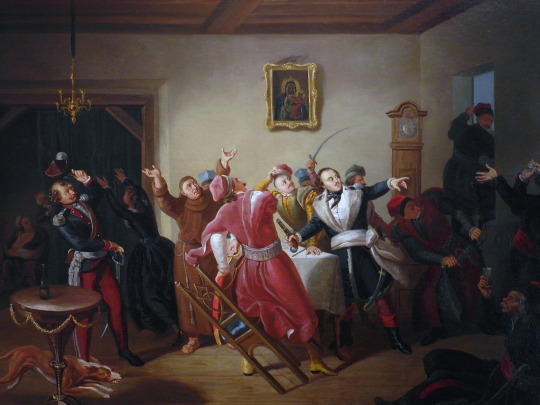
9.) NOTHING ABOUT US WITHOUT US While the king od France could've said "I am the state", in the Polish-Lithuanian Union the state were its citizens, that being the nobility. Nobility's agitation for their privileges gradually bore fruit - particularly important were the neminem captivabimus privilege, ensuring untouchability of a person, and the nihil novi rule, forbidding the king from issuing laws without the approval of a diet of nobles. Power of the nobility was among other things ensured by the size of this estate, since it made up 8-10% of the population (for comparison, in Great Britain, even in the mid-19th century only 6% of the population had a right to vote). In comparison with other countries, all members of the nobility were absolute equals in the eyes of the law. All of these rules were supported by the specific ideology of sarmatism, according to which were all noblemen, as the alleged descendants of the ancient ethnic group, required to protect the so-called "golden liberties" - set of rights and values which made the Polish-Lithuanian nobility consider themselves the most free nation under the the sun. Besides the exotic clothing [5], sarmatism was also expressed in numerous acts of rebellion against their own king - for example, in the 18th century nobility founded the Bar Confederation, which was supposed to rid the Commonwealth of the Russian influence, but ended up leading to the first division of Rzeczpospolita lands among the imperial powers.

10.) SPLENDOR AND MISERY OF THE MAGNATE FAMILIES Though in the Commonwealth, any use of titles that would distinguish between lower and higher nobility was strictly forbidden, the issue was nonetheless made more complicated by the high economic inequality even among the nobles. Some noble houses were able to create estates so large even the royal holdings paled in comparison. Their dominance rested on their large wealth, high positions in state offices and background influence on politics. This informal class of magnates was most prominent in the eastern part of the country, where a handful of houses amassed giant private armies and sophisticated webs of noble clients, since many of the impoverished nobles voluntarily worked for the magnates, and some even voted in the parliament according to the wishes of their benefactors. These most powerful magnates were thus also titled "little kings", and some of them actually did become elected kings of Poland. The fact that many magnates, especially in Ukraine, were out of the reach of central state power and treated their subjects especially badly led to the outbreak of antimagnate rebellions, the most successful of which was the Bohdan Khmelnytsky Cossack uprising of 1648. However, the magnate activity cannot be seen as black-and-white, because their role also involved foundation and patronage on a grand scale - it was thanks to them that many treasures of Polish-Lithuanian architecture were created.

11.) LEGACY OF THE REPUBLIC OF MANY NATIONS The Republic of Poland-Lithuania was erased from the map in 1795. However, its tradition remained in the ethos of fight "for freedom yours and ours", which was echoed by the participants of many antirussian uprisings in the 19th and 20th century. This ethos called back to the tradition of free republic, which, unlike the Russian Empire - that forced subjugated polities to adopt the samoderzhavie [6], orthodoxy and russification triad - supposedly enabled different nations to keep their freedom and "unity in diversity". Although the ethnonationalism of the 20th century has dimmed the memories of their common legacy and caused plenty of bad blood among the different nations of former Rzeczpospolita, the idea of confederation or close cooperation against Russian imperialism was returning in their consciousness, whether during the 1863 uprising or shortly after World War I. In the communist era, the writer in exile Jerzy Giedroyc famously prophesized that Poland can be truly free only when so are Lithuania, Belarus and Ukraine. For Ukrainians and Belarussians, who have been threatened by the imperial idea of Greater Russia and the vision of a unified "Russian world" even after 1991, are heroes (like prince Konstanty Ostrogski or hetman Sahaidachny) and famous moments in the history of the Republic fundamental symbols of their national sovereignty and belonging to the European civilizational space. They will never cease to remind everyone that the Republic is not dead while we are alive and believe that the ties of mutual civic loyalty are stronger than differences in language, faith or ethnic origin, stronger than any enemy that would attempt to tear these ties of our values.
***
[1] - Russia. They are talking about Russia. Y'see, the etymology of "Russian" in Eastern Slavic languages is kinda confusing; originally, it meant all Eastern Slavs, but later on it came to be associated with the largest and most culturally dominant group - which is to say the predecessors of modern Russians under the rule of Princedom of Muscovy. Eventually, Ivan IV., the Grand Prince of Muscovy got himself crown the Tsar of All Russians, which was a bit presumptuous considering a whole lot of people who very much weren't under his rule also identified as the Rus'/Russians. Still, it stuck, and when Ukrainians and Belarussians wanted to define themselves against their Russian overlords, they abandoned the label "Russians" altogether. Calling post-Ivan the Terrible Russians "Muscovites" is a bit of antiquated terminology that would be common in Polish-Lithuanian Commonwealth.
[2] - Literal translation, because I don't know what it's called in English-speaking historical literature.
[3] - Used here in the older sense of the word, i.e. Eastern Slavic in general (see [1]). In this case, the Eastern Slavs in question are clearly mostly Ukrainians despite being called Rus'/Russians (YES I KNOW)
[4] - Okay, so have you seen the first episode? The whole "One of us was against. End of story. We have a democracy." thing was... Barely an exaggeration to be honest.
[5] - Compare the shit Jan Paweł and his friends wear to normal 17th century male clothing (to which Ciesław and especially magnate's son come pretty close to) and you'll get the gist.
[6] - rus. autocracy, or rather the name for specific absolutist tradition of Russian tzars
***
Notes on the pictures:
1.) Map of Rzeczpospolita from the first half of the 18th century (most likely around 1739), made by the cartographer Johann Baptist Homann.
2.) Tapestry with the coats-of-arms of Poland and Lithuania - The Union of Lublin led among other things to the joining of Polish and Lithuanian coats-of-arms, so the new state coats-of-arms combined the polish royal eagle on red field with the traditional symbol of Lithuania, the Pogoń (Vytis in Lithuanian), or the armored knight on a horse, which to this day is part of the legacy of the Grandduchy in modern Lithuanian and parts of Belarussian society.
3.) Battle of Orsha (1514) in which the orthodox prince Konstanty Ostrogski, claiming to carry on the legacy of the Kievan Rus', led the united Polish-Lithuanian forces and destroyed the Muscovite invasion army despite being outnumbered, saving the independence of the Grandduchy. After 1991 the day of the anniversary of this battle was celebrated as a holiday of the Belarussian army. The holiday was later abolished by the Lukashenko regime, one can currently end up in jail for celebrating it. In 2017, a common Lithuanian-Polish-Ukrainian brigade was named hetman Ostrogski.
4.) Royal Castle in Warsaw - Since the late 16th century, Warsaw became the new center of power in the Republic. The Royal Castle, originally the medieval seat of the dukes of Massovia, was rebuilt in the new baroque style. During World War II, the castle was completely destroyed. For a long time, the communist regime was refusing to greenlight its reconstruction, and its restoration based on old engravings and pre-war photographs was only made possible trough the massive public pressure.
5.) Painting of the French artist Jean-Pierre Norblin portrays a traditional part of the political life in Rzeczpospolita - a session of the so-called sejmik (Polish diminutive of sejm, a.k.a. diet). On these local assemblies of nobles of the given region, deputies for the meetings of the central sejm were elected and instructions for these deputies were agreed upon.
6.) Kruszyniany - Presence of the muslim Tartar community is part of the legacy of Rzeczpospolita. Tartars live on the territories of today's Lithuania, Belarus and Poland continuously since the 14th century. They have proven their worth as warriors in service of the Republic. Original Tartar mosques can be found especially in Podlesie in today's northeastern Poland and in Trakai in today's Lithuania.
7.) Ceiling of a synagogue reconstructed for the POLIN Museum of the History of Polish Jews in Warsaw, which in 2015 was awarded the title of Best Museum in Europe. It is in this modern museum that you can learn the most about the Jews of Rzeczpospolita, the largest Jewish diaspora at the time.
8.) Sobieski at Vienna - Painting of Jan Matejko depicts the Polish king Jan III. Sobieski, who after his famous triumph over the Ottoman Turks in 1683 sent a letter to pope Innocent IX., in which he writes that the Christian Vienna was saved.
9.) Casimir Pulaski, later national hero of the United States, escaped Poland after the failure of the Bar Confederation in 1769-1772. The confederation was one of the last attempts to free the country from the increasing dependency on Russia.
10.) Zamoćś - Renessaince city founded by an exceptional person. Jan Zamoyski came from a not very wealthy noble family, but trough his own merits eventually became the richest and most powerful man in the Republic. The town hall of Zamość on the photo.
11.) Adam Mickiewicz could be the symbol of the common legacy of Rzeczpospolita. The greatest poet in the Polish language literature was born in today's Belarus (1798) and always felt like a citizen of Rzeczpospolita. His most important work begins with a line "Lithuania, my fatherland!" It was Mickiewicz who was remembered by the pope John Paul II., when he proclaimed the Polish-Lithuanian Commonwealth the predecessor of cooperation of the entire continent within the European Union ("from the Union of Lublin to the European Union").
12 notes
·
View notes
Text
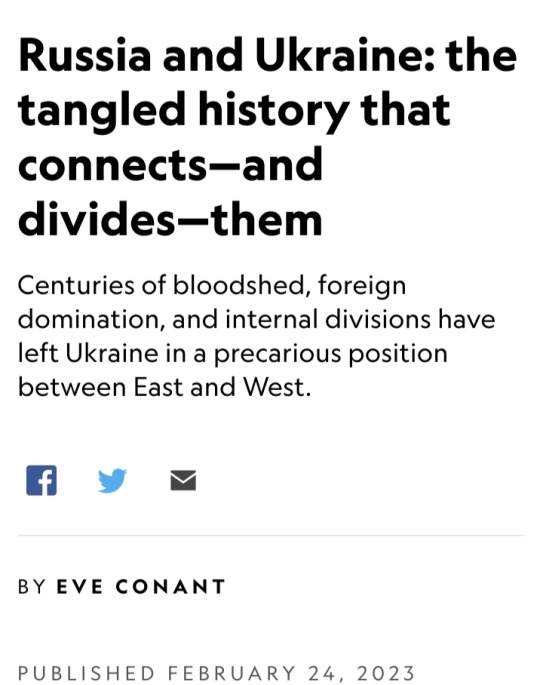
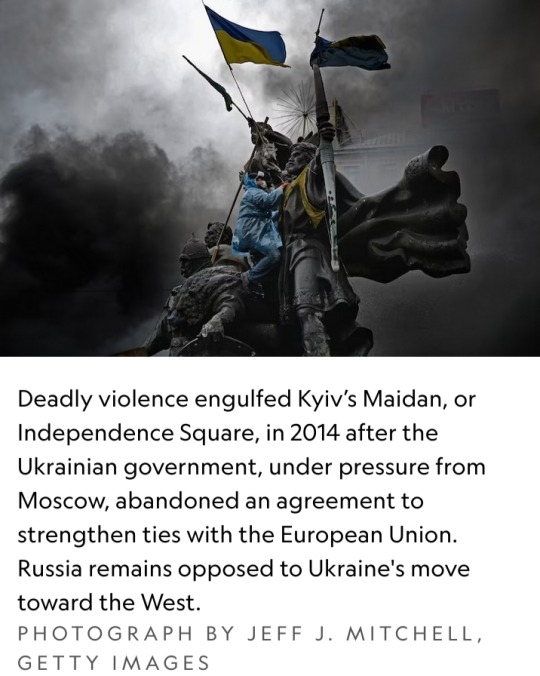
It’s been a year since Russia invaded Ukraine, and the battle continues.
Military and civilian deaths and injuries on both sides have been estimated in the hundreds of thousands, and millions more Ukrainians have been displaced.
What set the stage for today’s conflict? Here’s a look back at the long, intertwined history of the contentious neighbors.
The two countries’ shared heritage goes back more than a thousand years to a time when Kyiv, now Ukraine’s capital, was at the center of the first Slavic state, Kyivan Rus, the birthplace of both Ukraine and Russia.
In A.D. 988, Volodymyr the Great, the pagan prince of Novgorod and grand prince of Kyiv, accepted the Orthodox Christian faith and was baptized in the Crimean city of Chersonesus.
From that moment on, Russian leader Vladimir Putin recently declared, “Russians and Ukrainians are one people, a single whole.”
Yet, over the past ten centuries, Ukraine has repeatedly been carved up by competing powers.
Mongol warriors from the east conquered Kyivan Rus in the 13th century.
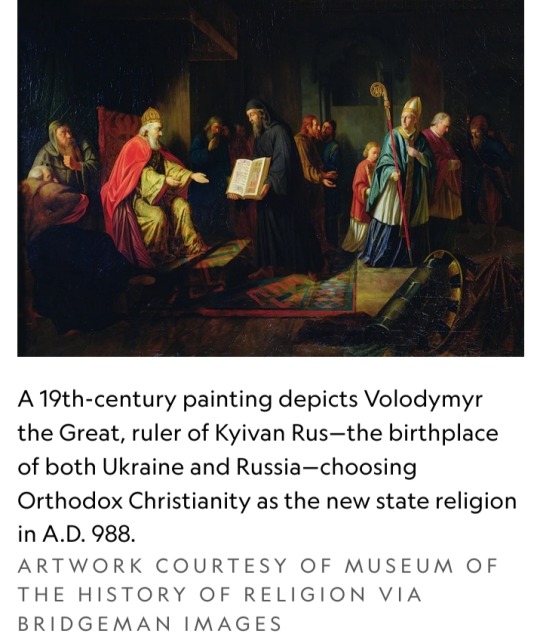
In the 16th century, Polish and Lithuanian armies invaded from the west.
In the 17th century, war between the Polish-Lithuanian Commonwealth and the Tsardom of Russia brought lands to the east of the Dnieper River under Russian imperial control.
The east became known as "Left Bank" Ukraine; lands to the west of the Dnieper, or "Right Bank," were ruled by Poland.
More than a century later, in 1793, right bank (western) Ukraine was annexed by the Russian Empire.
Over the years that followed, a policy known as Russification banned the use and study of the Ukrainian language, and people were pressured to convert to the Russian Orthodox faith.
Ukraine suffered some of its greatest traumas during the 20th century.
After the communist revolution of 1917, Ukraine was one of the many countries to fight a brutal civil war before being fully absorbed into the Soviet Union in 1922.
In the early 1930s, to force peasants to join collective farms, Soviet leader Joseph Stalin orchestrated a famine that resulted in the starvation and death of millions of Ukrainians.
Afterward, Stalin imported large numbers of Russians and other Soviet citizens—many with no ability to speak Ukrainian and with few ties to the region—to help repopulate the east.
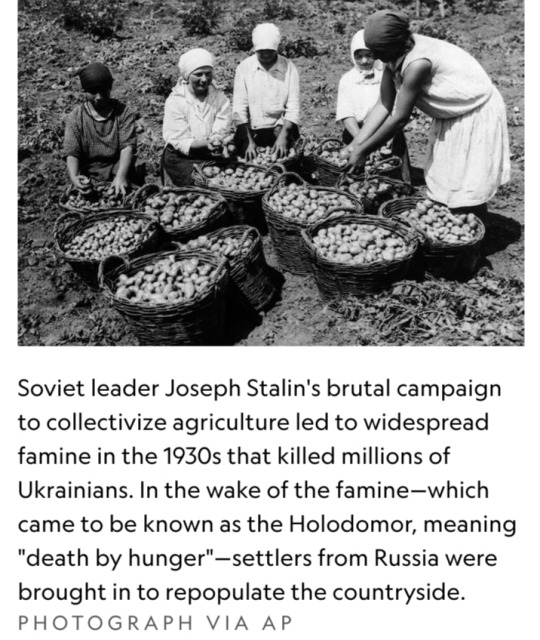
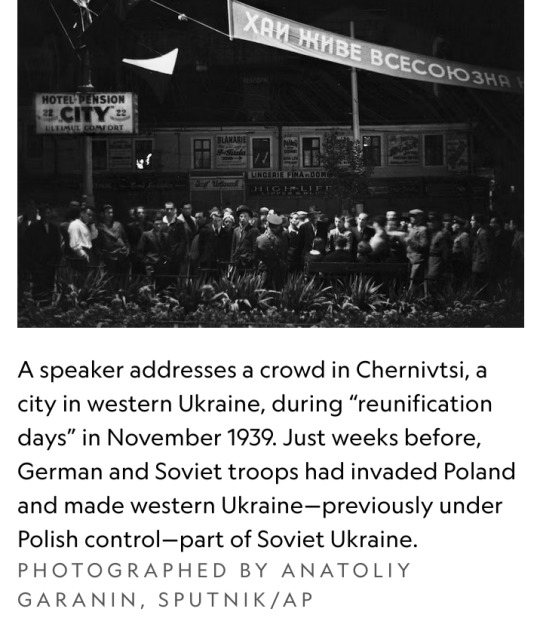

These legacies of history created lasting fault lines. Because Eastern Ukraine came under Russian rule much earlier than western Ukraine, people in the east have stronger ties to Russia and have been more likely to support Russian-leaning leaders.
Western Ukraine, by contrast, spent centuries under the shifting control of European powers such as Poland and the Austro-Hungarian Empire — one reason Ukrainians in the west have tended to support more Western-leaning politicians.
The eastern population tends to be more Russian-speaking and Orthodox, while parts of the west are more Ukrainian-speaking and Catholic.
With the collapse of the Soviet Union in 1991, Ukraine became an independent nation. But uniting the country proved a difficult task.
For one, “the sense of Ukrainian nationalism is not as deep in the east as it is in west,” says former ambassador to Ukraine Steven Pifer.
The transition to democracy and capitalism was painful and chaotic. Many Ukrainians, especially in the east, longed for the relative stability of earlier eras.

"The biggest divide after all these factors is between those who view the Russian imperial and Soviet rule more sympathetically versus those who see them as a tragedy," says Adrian Karatnycky, a Ukraine expert and former fellow at the Atlantic Council of the United States.
These fissures were laid bare during the 2004 Orange Revolution in which thousands of Ukrainians marched to support greater integration with Europe.
On ecological maps, you can even see the divide between the southern and eastern parts of Ukraine—known as the steppes—with their fertile farming soil and the northern and western regions, which are more forested, says Serhii Plokhii, a history professor at Harvard and director of its Ukrainian Research Institute.
He says a map depicting the demarcations between the steppe and the forest, a diagonal line between east and west, bears a "striking resemblance" to political maps of Ukrainian presidential elections in 2004 and 2010.
Crimea was occupied and annexed by Russia in 2014, followed shortly after by a separatist uprising in the eastern Ukrainian region of Donbas that resulted in the declaration of the Russian-backed People’s Republics of Luhansk and Donetsk.
Today, the two countries find themselves in conflict yet again, fault lines that reflect the region's tumultuous history.
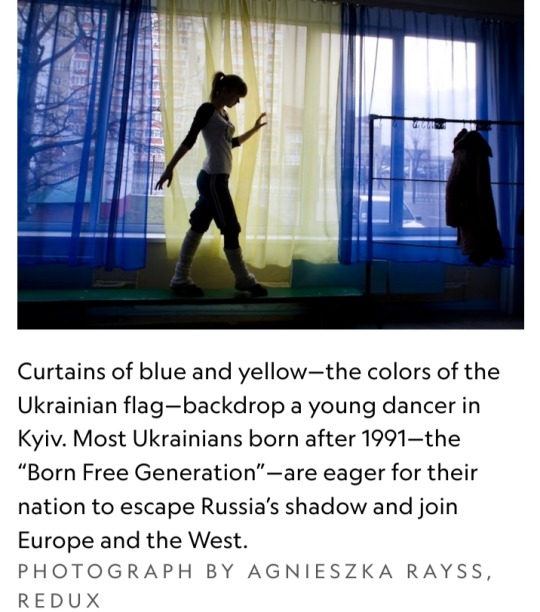
Portions of this article were originally published during the 2014 Crimean crisis. It has been updated to reflect current events.
#Ukraine#Russia#Kyiv#Kyivan Rus#Volodymyr the Great#Vladimir Putin#Russification#Joseph Stalin#2004 Orange Revolution#Volodymyr Oleksandrovych Zelenskyy#Volodymyr Zelenskyy
41 notes
·
View notes
Text
In a speech in Warsaw on Tuesday, U.S. President Joe Biden praised his Polish hosts for their foresight on the threat posed by Russia and their contributions to defending Ukraine. “Thank you, thank you, thank you for what you’re doing,” Biden said. But post-communist Poland hasn’t only been a success on matters of diplomacy and security. It has also been the most successful economy in Europe, in relative terms, since 1989—more dynamic not only than other Eastern European countries but also Europe’s big heavyweights France and Germany. That economic story is a central part of Poland’s growing influence on the continent and in the world more broadly.
How has Polish history shaped its economic identity? What factors have fueled its economic rise? And to what degree has its economic success been helped, or hindered, by its populist governments? Those are a few of the questions that came up in my recent conversation with FP economics columnist Adam Tooze on the podcast we co-host, Ones and Tooze. What follows is an excerpt, edited for length and clarity.
For the full conversation, look for Ones and Tooze wherever you get your podcasts.
Cameron Abadi: Poland has a remarkable history. It was wiped off the map in the 18th century and invaded from both directions, by Germany and Russia, in the 20th century. How has that longer-term history shaped its present-day political and economic identity?
Adam Tooze: Yeah, it’s a truly staggering history. If you look at an early modern map—a map of Europe in, say, 1600—then the Polish-Lithuanian Commonwealth was in fact the dominant power of Central and Eastern Europe. But the 18th century is a disaster. Poland ends up being divided between an ambitious Prussia, the Habsburgs, and the Russians. So, for a new Poland to emerge, which is the story of the 20th century, it basically needs a hegemonic patronage of one of those three powers, or it needs all three of them to be defeated, a kind of miracle.
And that’s precisely the miracle that transpires at the end of World War I. All three of them are defeated in sequence. First the Russians, then the Hapsburgs and the Prussians within days of each other. And by the end of 1918, Poland is established as a national unit. But it was, as you were saying, overtaken again by the aggression of its neighbors, smashed and divided between Nazi Germany and the Soviet Union in 1939. And then you have a new phase of economic and social development under communism, which—well, of course, what we know about communism in the long run is that it’s an economic failure, but it wasn’t from the start. And for better and for worse, one thing that Soviet-era dominance and the common rule of the Soviet Communist Party did, it industrialized Poland, it urbanized Poland, and it set a much higher bar for Polish education. The percentage of Poles in university increased tenfold between the interwar period and the 1970s. It laid the grounds for the modern Polish success story that we’re focusing on, this incredible period of growth with a Poland inserted into, on the one hand, the European Union and, on the other hand, NATO.
But the scars of this history do linger. And that then creates this space not just for coming to terms with real lived trauma but also the politics of Polish nationalism, which, especially since the election of the Law and Justice party in 2015, now dominates the Polish political scene. This nationalism has opened up a variety of historical legacies simultaneously: the reparations issue with Germany, where Poland is demanding over 1 trillion euros in reparations for the damage done to Poland during the German occupation, but also now, of course, the confrontation with Russia over its attack on Ukraine. One interesting effect of all of that is that long-standing, historic legacies of tension between Poland and Ukraine—which fought wars with each other at the end of World War I, in the phase in which both of them were struggling for independence—have been papered over and buried so that Ukraine and Poland are now closely allied in the struggle against Vladimir Putin’s Russia.
CA: When you get into the details of Poland’s development, it seems to have relied a lot on foreign direct investment—foreign firms setting up manufacturing hubs across the country. How much does this success have to do with specific policy choices that Poland has made versus simply the good luck of being geographically adjacent to the EU economic heavyweight that is Germany?
AT: I think the geographical factor is no doubt highly significant because it can’t be ignored that practically all of the former communist Eastern European states, all of which are more-or-less close to Germany and to the EU, have all done quite well. So Poland is the standout case with a growth rate since 1989 of 179 percent. But take Lithuania or Latvia or Slovakia, and they’ve all achieved 125-130 percent growth. Romania achieved a doubling of output. Slovakia, Chechnya, Hungary—which were much better off than Poland in 1990—grew by 70 percent. So everyone in that zone has achieved a relatively successful transition by comparison with, for instance, Belarus or Ukraine or indeed even Russia. And they were all, in that sense, relatively well placed. I think that’s important. I think it’s important also to be clear that Germany is a big part of this. Germany accounts for 26 percent of Polish exports, which is five times more than the next-placed country, which would be the Czech Republic and then the United Kingdom at 5 to 6 percent each.
So Germany is a key part of the Polish success story—but only in the context of Europe as a whole. So you spoke about foreign direct investment. There’s about 40 billion euros’ worth of German foreign direct investment in Poland, and that’s by comparison with the 140 billion euros that have been pumped into Poland since 2004 by the EU as a whole. So the EU matters more here.
If you ask in what ways did the Polish policies themselves inflect this, Poland is bitterly divided over what you might think would be an economic success story. And the current incumbent nationalist party is a party of ideological warfare. They campaigned on the slogan, believe it or not, “Poland in Ruins.” So what is at stake here? Well, the advocates of the Polish success story say that what Poland imposed after communism was shock therapy—they liberalized prices, they let the market rip, they allowed a wholesale destruction of communist-era economic security, a huge surge in unemployment, the bankruptcy of a whole bunch of Polish businesses—but what they crucially didn’t do was privatize early on. So they avoided the formation of the baneful system of oligarchs that we saw in Russia and many of the post-Soviet states: Ukraine, Belarus, and so on.
This is the story as the boosters of the Polish success story tell it. But what can’t be discounted is that there is a counternarrative that sees the ’80s and the ’90s—for all of the apparent success of the transition to capitalism, to Europe, and to democracy—as in fact a corrupt sellout, not on the scale of Russian chaos in the 1990s but nevertheless a subversion of the new Polish order by the corrupt holdovers of the communist period. And without reckoning with this difference of narratives about what, on the basis of the macroeconomic data, looks like a spectacular success story, you can’t understand how savage Polish politics has been in the last 15 years. The Law and Justice party has that name because it believes that those are the things that are at stake. I mean, in the West, we regard it as an unjust party that subverts the rule of law. But in their own terms, they understand themselves as bringing a new order and an end to the corrupt long-term legacies of the botched transition.
CA: The Law and Justice party has been in power for several years, and it has also presided over continued economic growth. To what extent is its economic success traced to its populist status exactly? Are there specific populist platforms or ideas that have proved economically successful?
AT: It’s really an interesting question, and I think it sort of raises the question of how we link short-run economic measures, welfare measures, and economic growth. I mean, the populists in Poland have been lucky in that they’ve inherited a growth engine, and that’s continued to work with considerable dynamism and has powered the Polish economy over the long run. And so, to that extent, I think we should probably separate that logic of economic growth from the comings and goings of governments and the policies they adopt.
It’s also true that they have, however, adopted significant welfare policies. So they came into power promising to rescue their country, widely regarded as an economic success story, from the ruins that had been created by the decades of unequal pro-Western growth since the 1990s. And they promised to do this by lowering the retirement age, rolling it back from 67 for both men and women to 65 for men and 60 for women. Expanding family benefits, they created this 500 zloty—which is about a 110 euros a month—payment for families with more than with two kids and upwards. And then they also set about building new apartments on state-owned land, a kind of program of investment, a redistribution. And it’s not inconceivable that welfare spending could in various ways enhance the growth potential of a country. It could help build human capital. In the health sector, it could be the driver of technological change. But this sort of spending really doesn’t fall into that category. It’s hard to see how any of these measures could really increase Poland’s long-run growth rate.
So I think really what we’re talking about now in Poland is a sort of subtle balance of a growth machine shaped in the 1990s that at least has some distance to run still—there’s that story. And then there’s a story essentially that is driven by the toxic politics of the aftermath of communism in Poland on the one hand and on the other hand the story of regional and social inequality. And if you dig down, if you really dig into the data, it’s pretty obvious that the drama here is that Polish society since the 1990s has experienced truly dramatically diverging fortunes. If you look at the top 1 percent of Polish society, their incomes have more than quadrupled—they probably increased by 450-odd percent. So what we’re really talking about is a society not unlike others in the world since the 1990s but a particularly extreme case of a society that was once relatively solidaristic under communism and has now been divided in really quite fundamental ways by economic growth.
And what the populist politics quite precisely identifies are those gaps, those spaces in between, and sets about remedying them in a rather direct way. One of the extraordinary things about Polish politics recently is people are just not afraid to buy votes. They wave a benefit and get votes for it, which is in some ways a degeneration of democracy. But it speaks to a very specific need. But it seems quite unrelated to the underlying growth dynamic that feeds it.
4 notes
·
View notes
Text
9 famous castles of Ukraine — witnesses of noble past
Castles are among the most interesting historical monuments in Ukraine. According to researchers, there were more than 5,000 fortifications in Ukraine, but most of them are gone today. To date, 116 Ukrainian strongholds have fully or partially survived.
Though inanimate and silent, having belonged to different state territories and nations in the past, these castles still tell their stories as witnesses of crucial events in European and Ukrainian history. Now they constitute Ukrainian heritage to be cherished and preserved. In this publication, we would like to tell you about the nine most famous castles in Ukraine.
Kamianets-Podilskyi Fortress
The first wooden fortification in Kamianets refers to the 11th century, later rebuilt in stone. In the 14th century, it acquired a contemporary look. Only twice in its history, the fortress has been conquered: in 1393 by Lithuanian Prince Vytautas and in 1672 by a large Turkish army that remained here until 1699. Kamianets-Podilskyi Fortress lost its defensive significance after the end of the Russo-Turkish War of 1812 — when the borders of the Russian Empire expanded significantly to the south. At that time, the fortress served as a prison. However, during the two world wars, it was used as a fortification again.
Kamianets-Podilskyi Fortress is well-preserved to this day. It occupies 1.5 hectares and consists of eleven towers arranged in an irregular quadrangle and connected by fortress walls. For its architectural ensemble that has no analogy in Europe, Kamianets-Podilskyi Fortress is included in the UNESCO World Heritage Site Tentative List.
Khotyn Fortress
The first reliable fortifications, in the form of a rampart with wooden barriers and a moat dug across the rocky cape, appeared in Khotyn at the turn of the 10th and 11th centuries. After annexing this territory to Rus, Kyivan Prince Volodymyr the Great started building new fortresses as centers of princely power and places of residence for governors.
In 1621, Khotyn witnessed the war between the Ottoman Empire and Poland, in which the Ukrainian Cossacks played a crucial role. The victory at Khotyn saved Western Europe from the Turkish invasion.
Khotyn Fortress has survived to this day in an authentic state. Today, it is a state historical and architectural reserve. Knight Tournaments “Battle of Nations” are often held here, and historical films are shot.
Akkerman Fortress
Akkerman Fortress, or White Fortress, is a unique monument of fortification architecture of the 13th-15th centuries.
The fortress was under Turkish rule for more than 300 years. In 1789, Akerman came under the control of Russian troops and gradually lost its military and defense function. The historically formed planning and spatial structure have mostly been preserved to modern days. Since the early 20th century, restoration work has been carried out here to adapt this historical and architectural complex for cultural and tourist purposes.
Mukachevo Palanok Castle
Mukachevo Palanok Castle was built on the crossroads of ancient trade and military routes at the end of the 13th century. It served as a stronghold for the northeastern part of the Hungarian Kingdom and Austrian Empire. Overcoming sieges and wars, Palanok Castle is one of only five fortresses in Europe that have never been seized by a storming attack. The castle consists of 130 different rooms with a complex system of underground passages connecting them. Currently, it houses a museum dedicated to the history of Mukachevo and the castle.
Olesko Castle
The 600-year-old Olesko Castle near Lviv belonged at different times to Lithuania, Poland, and Hungary and witnessed constant battles for ownership. It is the birthplace of Polish Kings — Jan III Sobeski and Michał Korybut Wiśniowiecki.
Today, it is a museum featuring collections of antique furniture and art, tapestries, ancient weapons and everyday life items from the 16th and 17th centuries. This collection is considered one of the richest treasuries of Polish art outside of Poland.
Pidhirtsi Castle
This residential castle-fortress was erected 80 km east of Lviv in the 17th century for the Polish Grand Crown Hetman Stanislaw Koniecpolski. Above the entrance gate, a marble plaque to this day bears a Latin inscription: “A crown of military labors is victory, victory is a triumph, triumph is rest.” The interior of the castle saw Polish Kings and military commanders.
During World War I, its splendor suffered devastation and looting by Russian troops. Soviet authorities opened a tuberculosis sanatorium there after World War II. Nowadays, Pidhirtsi Castle is in the register of 100 world monuments that need immediate restoration.
Svirzh Castle
Svirzh Castle was built under the patronage of the influential Svirzh family in the 15th century. Only fragments of the foundation and lower walls have survived from that heroic period. When the castle was owned by the Zetner family (second half of the 17th — early 19th centuries), the castle complex acquired a modern look, transforming from a purely defensive structure into a cozy residence.
The owners cherished and persistently revived their estate from the ruins during the Cossack wars and the Polish-Turkish confrontation and saved it from vandalism by Russian troops. The last of the noble family, Ignacy Zetner, created a magical park around the castle. During World War I, the Svirzh Castle became the center of active hostilities, and as a result, it stood in ruins for more than 30 years. The restoration of the castle began only in 1975. Now, Svirzh Castle is reopened for tours. It is planned to create a cultural and artistic center here.
Lutsk Castle
Lutsk Castle, also known as the Castle of Lubart, was founded in 1340 when Lithuanian Prince Lubart ordered the construction of stone walls instead of wooden ones that had existed since 1000. In 1366, the city of Lutsk was captured by Polish troops, and since then, Lutsk has become both the permanent residence of the prince and the capital of the principality.
The reliability of the fortress was well-known in European countries, so it is not surprising that it was here, in the Upper Castle in Lutsk, that the Congress of Monarchs was held in 1429 — 15,000 people came to Lutsk to discuss the most burning political and economic issues of the time.
Lubart’s Castle withstood numerous assaults and sieges, but over time, the lack of financing to maintain the castle caused the defensive structure to decay. It lost its fortification function and served only to house the administration and courts.
Now, Lutsk Castle is a symbol of the city, attracting visitors to various festivals and cultural events. The Entrance Tower of Lutsk Castle is depicted on the 200 UAH bill.
Uzhhorod Fortress
The foundation of the castle in Uzhhorod dates back to the 9th century and is associated with the legendary Hungarian Prince Laborets. In the 10th century, the territory of the citadel was conquered by the Hungarians, who began to build a new structure. In the early 14th century, King Charles Robert granted the castle to the Italian family of Drugeti. The Drugeti counts owned the palace for almost four centuries. They invited Italian craftsmen to rebuild the castle — strong fortification walls were erected, and the complex acquired a Renaissance style. From the end of the 17th century, Uzhhorod Castle passed into the hands of Hungarian count Miklós Bercsenyi, who, together with his wife, turned it into a pompous count’s residence, the center of the cultural and political life of the region. In the middle of the 18th century, the palace housed a theological seminary until the arrival of Soviet troops in the 1940-s.
From 1947 till nowadays, the castle has been a local history museum that contains the largest collection of bronze treasures and Celtic antiquities in Ukraine, a numismatic collection, rare manuscripts and printed books, embroidered shirts, folk clothes, and folk musical instruments of Transcarpathia, cold steel and firearms of the 16th-20th centuries.
Text: Liubov Pikulia Design: Vladyslav Rybalko
0 notes
Text

Russia and Ukraine have a complex and contentious history. Here's a brief overview:
Historical Background: Ukraine has a rich history and a distinct cultural identity. It was part of various Eastern Slavic state formations throughout the centuries, including the Kyivan Rus, which was a predecessor to both Russia and Ukraine. Ukraine later fell under the rule of the Polish-Lithuanian Commonwealth and the Russian Empire.
Soviet Era: After the Russian Revolution of 1917, Ukraine experienced a period of independence from 1917 to 1921, but it eventually became part of the Soviet Union in 1922. During the Soviet era, Ukraine went through significant political and demographic changes, including the 1932-1933 Holodomor, a man-made famine that resulted in millions of deaths.
Dissolution of the Soviet Union: With the collapse of the Soviet Union in 1991, Ukraine gained independence. However, the dissolution led to challenges, including economic difficulties and political instability. Ukraine sought to establish its own identity and pursue a path separate from Russia.
Crimea Annexation: In 2014, Russia annexed Crimea, a region that was previously part of Ukraine. The move was widely condemned by the international community, and it sparked a conflict between Russia and Ukraine.
Conflict in Eastern Ukraine: Since 2014, an armed conflict has been ongoing in eastern Ukraine between Ukrainian government forces and Russian-backed separatists. The conflict has resulted in thousands of deaths and displacement of people. Several ceasefire agreements have been reached, but the situation remains unresolved, with sporadic clashes occurring.
International Relations: The conflict in Ukraine has strained relations between Russia and the West, particularly the United States and European Union. Sanctions have been imposed on Russia, and diplomatic efforts have been made to find a peaceful resolution to the conflict.
It's important to note that this is a simplified overview, and there are many nuances and complexities involved in the relationship between Russia and Ukraine.
Gas Disputes: Russia is a major supplier of natural gas to Ukraine and Europe. Disputes over gas prices and transit fees have occurred between Russia and Ukraine in the past, leading to disruptions in gas supplies to Ukraine and, subsequently, to parts of Europe. These disputes have often been intertwined with broader political tensions.
Cultural and Linguistic Differences: Ukraine has a distinct culture and language. While Ukrainian is the official language, Russian is widely spoken, especially in eastern and southern regions where there is a significant Russian-speaking population. The language issue has sometimes been a source of tension and political debate within Ukraine.
Geopolitical Considerations: The conflict in Ukraine is seen by many as a manifestation of broader geopolitical rivalries between Russia and the West. Ukraine has sought closer ties with the European Union and NATO, which Russia views as a threat to its influence in the region. The West has provided political and economic support to Ukraine, but there are divisions among Western countries on the approach towards Russia.
Humanitarian Impact: The conflict in eastern Ukraine has had a significant humanitarian impact. It has resulted in casualties, displacement of people, damage to infrastructure, and disruption of daily life for many residents. Humanitarian organizations have been providing assistance to those affected by the conflict.
Minsk Agreements: The Minsk agreements, signed in 2014 and 2015, aimed to establish a ceasefire and a political resolution to the conflict in eastern Ukraine. However, full implementation of the agreements has been challenging, and the conflict has continued, with periodic escalations and violations of the ceasefire.
International Diplomatic Efforts: Various countries and international organizations have been involved in diplomatic efforts to resolve the conflict, including the Normandy Format (involving Ukraine, Russia, France, and Germany) and the Trilateral Contact Group (Ukraine, Russia, and the Organization for Security and Co-operation in Europe). These efforts have aimed to facilitate dialogue, ceasefire implementation, and a peaceful resolution.
Crimea's Status: The annexation of Crimea by Russia in 2014 has led to a significant shift in the region's status. Russia considers Crimea as part of its territory, while Ukraine and most of the international community continue to view it as an integral part of Ukraine. The annexation has not been recognized by the United Nations or many countries around the world.
Donbass Region: The conflict in eastern Ukraine primarily revolves around the Donbass region, which includes the Donetsk and Luhansk provinces. These areas have seen heavy fighting between Ukrainian government forces and separatist groups supported by Russia. The conflict has resulted in a de facto separation of these territories from the rest of Ukraine, with the creation of self-proclaimed entities known as the Donetsk People's Republic and the Luhansk People's Republic.
Human Rights Concerns: The ongoing conflict has raised significant human rights concerns. There have been reports of human rights abuses, including civilian casualties, displacement, torture, and arbitrary detentions. Both Ukrainian forces and separatist groups have been accused of committing such violations, and international human rights organizations have documented these abuses.
Economic Interdependencies: Ukraine and Russia have deep economic interdependencies, including trade relations and energy cooperation. Ukraine is an important transit route for Russian gas exports to Europe, and Russia has used gas supplies as a political lever in the past. Efforts have been made to diversify Ukraine's energy sources and reduce its dependence on Russian gas.
Cyberattacks and Information Warfare: Russia has been accused of engaging in cyberattacks and information warfare targeting Ukraine. These activities include hacking, disinformation campaigns, and the spreading of propaganda. Cybersecurity concerns and the manipulation of information have become significant challenges in the region.
Crimea Bridge: In 2018, Russia completed the construction of the Crimean Bridge, connecting the Russian mainland to Crimea. The bridge has faced criticism from Ukraine and the international community as it reinforces Russia's control over the region and undermines Ukraine's territorial integrity.
Ongoing Negotiations: Efforts to find a peaceful resolution to the conflict continue through negotiations and diplomatic channels. However, progress has been slow and hindered by ongoing hostilities and divergent positions between the parties involved.
These points provide a broader understanding of the Russia-Ukraine dynamics, but it's important to note that the situation is complex and evolving. The geopolitical landscape and events may have changed.In conclusion, the relationship between Russia and Ukraine is characterized by a complex and contentious history. Ukraine gained independence from the Soviet Union in 1991 but has faced numerous challenges in its efforts to establish its own identity and pursue a path separate from Russia. The annexation of Crimea by Russia in 2014 and the ongoing conflict in eastern Ukraine have further strained their relationship.The conflict in eastern Ukraine, primarily centered around the Donbass region, has resulted in casualties, displacement, and significant humanitarian concerns. The international community has condemned Russia's actions and provided support to Ukraine, while diplomatic efforts have aimed to find a peaceful resolution.The situation is influenced by broader geopolitical considerations, with Ukraine seeking closer ties with the European Union and NATO, seen as a threat by Russia. Gas disputes, cultural differences, and human rights concerns also contribute to the complexities of the relationship.Efforts to resolve the conflict have been ongoing, with negotiations and diplomatic initiatives such as the Minsk agreements. However, challenges remain, and the situation is fluid, with periodic escalations and violations of ceasefires.It is important to note that this conclusion provides a summary of the key points discussed and the general state of the Russia-Ukraine relationship. The dynamics and developments in the region can change rapidly, and it is essential to stay informed about the latest updates from reliable sources.
0 notes
Text
Why intersectional theory doesn’t fit the description of ethnic discrimination in Eastern Europe (longread - I don't know if you will read this, but I think it's important)
Disclaimer 1: I am a historian, not a sociologist, and this affects my analysis. Disclaimer 2: I know best the history of the Russian Empire and least of all the Ottoman history. As we know, intersectional theory emerges from the concepts of "privilege" and "oppression". There are social categories that have greater access to benefits (education, good income, representation in art and media, etc.), and there are those that are oppressed for certain essentialist reasons, although the reasons are actually socially constructed (non-white skin color, non-straight sexuality, but you know about this without me). It’s important that such a system has been established for centuries, starting from about Early Modern times.
Intersectional theory is aimed at increasing the diversity of discourse and representing as many identities as possible in society. Also, the theory assumes a description of the intersections of various discrimination, where race, class, gender and sexuality aren’t separated from each other, but together form a person's identity. But ironically, this theory is very Americancentric, as it stemmed in large part from racial conflicts in the United States. It’s also partly Western Europeancentric, and includes mainly such colonial relations as between Britain and India, France and Algeria, etc.
But on the example of countries on the territory of the former Russian, Austro-Hungarian and Ottoman empires, it doesn’t work well, and here's why.
Mostly, the intersectional theory assumes the same type of conflicts and relations (racial, class, gender) in society over the centuries, which began to be established precisely in the late 15th - early 16th centuries, and this isn’t at all obvious for Eastern Europe.
Eastern Europe has distinguished itself by its "long" feudalism. Feudalism, on the other hand, means political fragmentation instead of absolutism, a greater concentration on religious affiliation (hello to the beginning of secularization in Western Europe) and the priority of status over class. Yeah, in capitalism it was difficult for a peasant to become a worker, and a worker (even more difficult) to become a small entrepreneur. But feudalism, in principle, doesn’t imply any social mobility - everyone is literally obliged to remain within the framework of their social strata.
Thus, the Polish–Lithuanian Commonwealth remained de facto politically fragmented up to partitions in 1795. The Russian Empire retained the priority of (Orthodox) religion over class until (!) the February Revolution in 1917. For example, in imperial Russia there was such a concept as the Pale of Settlement - a territory where Jews could live and were forbidden to move outside of it. At first glance, this looks like normal segregation, HOWEVER. Christianized Jews could live outside the Pale of Settlement, and especially rich and educated Jews had the right to do so. Yes, here it’s necessary to make disclaimers that there were such a minority and towards the end of the Russian Empire there was state discrimination of "privileged" Jews (for example, under tsar Alexander III). But we must take into account this "ambiguity" of social relations.
In the three empires, very different peoples lived side by side, who didn’t live segregated from each other, and built their identity not on "citizenship", but on the same religion or even on the area of residence. It can be said that Russians were an ethnic group in the Russian Empire, but this statement will tell you nothing about the relationship between Jews and Ukrainians, Poles and Romanians, Georgians and Armenians, etc. Moreover, empires had many mixed families, which significantly influenced attempts to build "nations" in these regions.
Serfdom existed for a long time in the Austro-Hungarian and especially in the Russian Empire. In fact, this is a form of slavery, but it extended to peasants, regardless of their ethnicity. In general, returning to the first point, the stratification here was very strict. In the Russian Empire, at the time the Bolsheviks came to power, 3/4 of the population were peasants and illiterate.
Oh yes, the Bolsheviks. The USSR in general confused everyone. At the beginning of the USSR, all nationalities were formally declared free (the Pale of Settlement and the priority of religion were abolished), but things went badly after the arrival of Stalin, under whose rule massive repressions were carried out against national minorities. At that time, many Germans lived in the USSR, who were a rather privileged community in the Russian Empire (recall that Catherine II was an ethnic German). But under Stalin, the Germans were among the first repressive and deported groups (largely due to the arrival of the Nazis in Germany and the invasion to the USSR). But by God, for reasoning about whether the USSR was an "empire" and what ethnic conflicts there were, 10 more posts are needed.
Finally, relations with the metropolises. Due to the redistribution of territories, the same territories with ethnic minorities belonged to different empires. The Balkans were part both of the Ottoman Empire and the Austro-Hungarian Empire, and Russia also wanted to annex them. As for today, the Czech Republic or Western Ukraine are unlikely to have any conflicts with Austria (but I’m not saying here about the entire Western European world). What can’t be said unequivocally about the Balkans and Turkey, and even more so about Russia and Belarus, Ukraine and Central Asia. In general, guys, it is possible to operate with intersectional theory only in the case of countries which 1) colonies were far from the metropolises; 2) capitalism developed early; 3) racial and ethnic minorities were severely segregated. And it hardly applies to countries that have been feudal for a long time, have gone through a massive revolution, a Soviet / nationalist dictatorship and suddenly become neoliberal.
#eastern europe#intersectionality#intersectional politics#colonialism#neocolonialism#post colonialism#history#us#western europe#russian empire#austro-hungary#ottoman#post soviet#capitalism#racism#nationalism#chauvinism
298 notes
·
View notes
Text
Jewish History Time!!!!!! 🕥
Hiiiiii
The Yiddish term for town, shtetl commonly refers to small market towns in pre–World War II Eastern Europe with a large Yiddish-speaking Jewish population. While there were in fact great variations among these towns, a shtetl connoted a type of Jewish settlement marked by a compact Jewish population distinguished from their mostly gentile peasant neighbors by religion, occupation, language, and culture. The shtetl was defined by interlocking networks of economic and social relationships: the interaction of Jews and peasants in the market, the coming together of Jews for essential communal and religious functions, and, in more recent times, the increasingly vital relationship between the shtetl and its emigrants abroad (organized in landsmanshaftn).
No shtetl stood alone. Each was part of a local and regional economic system that embraced other shtetls (Yid., shtetlekh) and provincial towns. Although the shtetl grew out of the private market towns of the Polish nobility in the old commonwealth, over time a shtetl became a common term for any town in Eastern Europe with a large Jewish population: towns not owned by noblemen in Poland, as well as towns in Ukraine, Hungary, Bessarabia, Bucovina, and the Subcarpathian region that attracted large-scale Jewish immigration during the course of the nineteenth century.
For all their diversity, these shtetls in Eastern Europe were indeed markedly different from previous kinds of Jewish Diaspora settlement in Babylonia, France, Spain, or Italy. In those other countries, Jews had lived scattered among the general population or, conversely, inhabited a specific section of town or a Jewish street. Rarely did they form a majority. This was not true of the shtetl, where Jews sometimes comprised 80 percent or more of the population. In many shtetls, Jews occupied most of the town, especially the streets grouped around the central marketplace. Poorer Jews would live further from the center and the frequently agrarian gentiles would often be concentrated on the peripheral streets, in order to be closer to the land that they cultivated.
This Jewish life in compact settlements had an enormous psychological impact on the development of East European Jewry—as did the language of the shtetl, Yiddish. Despite the incorporation of numerous Slavic words, the Yiddish speech of the shtetl was markedly different from the languages used by Jews’ mostly Slavic neighbors. While it would be a great mistake to see the shtetl as an entirely Jewish world, without gentiles, it is nonetheless true that Yiddish reinforced a profound sense of psychological and religious difference from non-Jews. Suffused with allusions to Jewish tradition and to religious texts, Yiddish developed a rich reservoir of idioms and sayings that reflected a vibrant folk culture inseparable from the Jewish religion.
The shtetl was also marked by occupational diversity. While elsewhere in the Diaspora Jews often were found in a small number of occupations, frequently determined by political restrictions, in the shtetl Jewish occupations ran the gamut from wealthy contractors and entrepreneurs, to shopkeepers, carpenters, shoemakers, tailors, teamsters, and water carriers. In some regions, Jewish farmers and villagers would be nearby. This striking occupational diversity contributed to the vitality of shtetl society and to its cultural development. It also led to class conflict and to often painful social divisions.
The experience of being a majority culture on the local level, sheer numbers, language, and occupational diversity all underscored the particular place of the shtetl as a form of Jewish Diaspora settlement.
Shtetls developed in the territories of the old Polish Commonwealth, where the nobility encouraged Jews to move onto estates in order to stimulate economic development. The eastward expansion of the commonwealth after the Union of Lublin in 1569 coincided with a growing market in Western and Central Europe for timber, grain, livestock and hides, amber, furs, and honey. Eager to develop their estates, the nobles needed competent managers and entrepreneurs—as well as regular markets and fairs. Jews were suitable instruments, especially because they could never become potential political rivals. thus developed the arenda (leasing) system, in which landlords leased key economic functions to a Jewish arendar (agent). Arenda usually included extensive subleasing, which further encouraged Jewish immigration to the landed estates. The manufacture and sale of alcoholic beverages—largely in Jewish hands—was particularly important as it gave landlords an important hedge against falling grain prices in export markets.
Noble magnates established private market towns and sought to attract Jews to reside in them. Economic competition from Christians in older cities in western and central Poland, as well as Jew-hatred fanned by the church and by guilds, also stimulated Jewish migration to the shtetls in the less-developed eastern regions of the commonwealth (today’s eastern Poland, Ukraine, Belarus, and Lithuania). These new towns—all centered on a market square—reflected an emerging symbiosis of nobles, Jews, and the surrounding peasantry. One side of the market would often feature a Catholic church, built by the local landlord as a symbol of primacy and ownership, with a synagogue on the other side. The weekly market days brought together Jews and peasants and created a web of relationships that were both economic and personal. Usually the landlords granted charters that precluded market days and fairs on the Sabbath or on Jewish holidays. The shtetls—with their synagogues, schools, ritual baths, cemeteries, and inns—also served as a base for the numerous dorfsgeyer, that is, Jews who would fan out to the villages as carpenters, shoemakers, and agents. Many Jews who lived lonely lives in the countryside as taverners, innkeepers, or leaseholders could come to the shtetl for major holidays and important family occasions.
While some shtetls date from the sixteenth century, the peak of shtetl development occurred after the 1650s, following the ravages of gzeyres takh vetat (the Khmel’nyts’kyi uprising) and the Swedish invasion. The nobility made a concerted effort to recoup their economic standing by establishing new market towns. The development of these shtetls coincided with an enormous demographic increase of Polish Jewry. While the Polish–Lithuanian Jewish population stood at perhaps 30,000 in 1500, by 1765 it had expanded to about 750,000. A striking feature of this Jewish settlement was its marked dispersion. By the 1770s, more than half of Polish Jews lived in hundreds of private towns owned by the nobility: about one-third lived in villages. In many Polish cities, Christian guilds and the Catholic Church fought to curtail Jewish residence rights.
With the collapse of the Polish Commonwealth in the late eighteenth century, the world’s largest Jewish community passed under Russian, Prussian, and Austrian rule. The anti-Russian Polish revolts of 1830–1831 and 1863 severely weakened the Polish nobility, and thus their Jewish partners. Nobles also suffered from the abolition of serfdom. The building of railroads and the rise of major urban centers helped create new regional and national markets that undercut the economic base of many shtetls. New peasant movements questioned the Jewish role in the rural economy and started cooperatives that undercut the shtetl. Moreover, progressive urbanization of peasants and the movement of Jews to the great cities that commenced in the second half of the nineteenth century meant that Jews became a minority in many towns where they had formerly predominated. In Galicia, shtetls suffered from economic pressures, but on the whole, Jews—especially after 1848 and 1867—benefited from a more liberal political regime. This was not the case in the Pale of Jewish Settlement in the Russian Empire.”
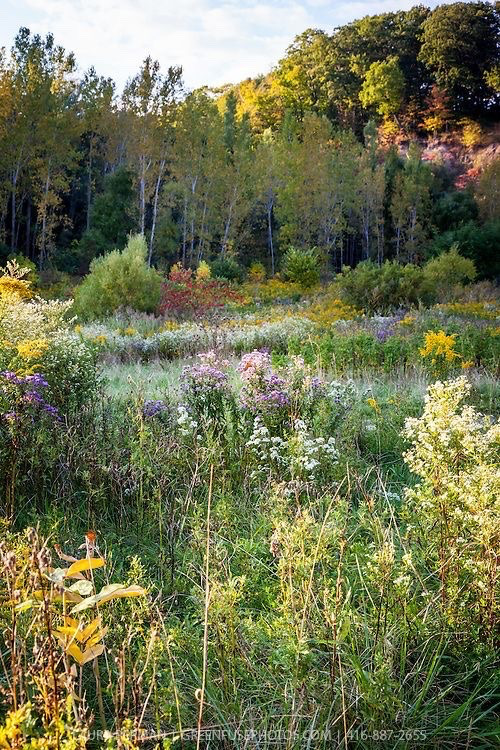
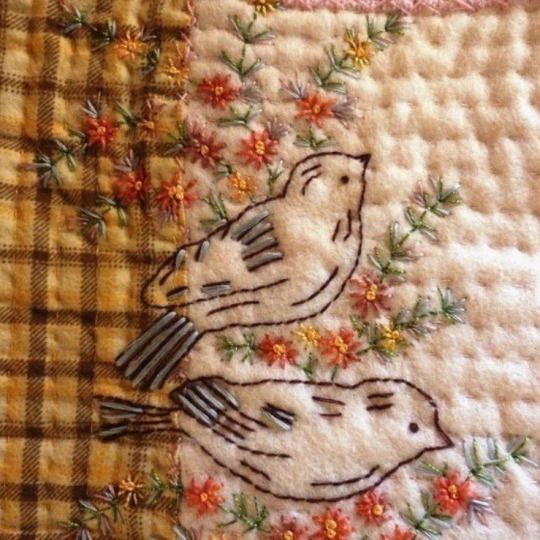
#israel#Jewish#Jumblr#Yiddish#Yiddishkheit#know ur history or else ur gonna be dumb afffff#israeli conflict#land#this is why we need Jewish communes and everyone in the universe who isnt already - to be hippies
169 notes
·
View notes
Text
wanted to actually illustrate what i meant by the relatively wishy-washy statements issued by slavic studies professional orgs vs. my former department's statement, which i quite liked, especially for its precise language & making clear that their objection was a matter of human cost & moral grievance, not just, like, an issue of Breaking The Rules re: international law or whatever. under the cut
ASEEES:
The Board of Directors of the Association for Slavic, East European, and Eurasian Studies condemns Russia’s military assault on Ukraine and President Putin’s use of historical distortions and cynical lies to justify Russia’s attack on Ukrainian sovereignty. We stand with all the people of Ukraine and Russia who oppose this war.
AATSEEL:
The Executive Council of the American Association of Teachers of Slavic and East European Languages condemns the unprovoked Russian invasion of Ukraine as a direct violation of international law. As scholars of this region, we are appalled by the distortions of the situation circulated on Russian state media. We grieve for the victims of the ongoing attacks and for those killed over the past eight years. We stand with all those in Russia, Ukraine, and beyond who oppose this war.
My department:
The Department of Polish, Russian, and Lithuanian Studies strongly condemns the Russian Federation’s invasion of Ukraine, and we wish to state our full solidarity with the people of Ukraine at this perilous time. While this disastrous conflict has global implications, we also recognize that it places a particular strain on the personal and professional lives of those who teach the languages, cultures, and histories of Eastern Europe and post-Soviet territories. Our department is composed of graduate students and faculty who have a variety of ties to this region—some of us hail from this part of the world, and others have dedicated their lives to better understanding it. Our student body is no less connected to these events than we are, and many of our students have relatives who resided—or still reside—in areas affected by conflict in Ukraine, Poland, Belarus, and Russia. We extend our solidarity and support to all of them and to our colleagues, the scholars and educators of Ukraine, Eastern Europe, and Russia who work every day to resist the senseless and destructive actions of the government of the Russian Federation against Ukraine and the people of Ukraine.
12 notes
·
View notes
Text
Langblr culture challenge
Day 2: History
During the Neolithic, nomadic pastoralism developed in the Pontic-Caspian steppe, which covers modern-day southern Russia.
In the 8th century BCE, Ancient Greeks created trade emporiums in southwest Russia.
Between the 3rd and 4th centuries CE, the Gothic kingdom of Oium was founded in southern Russia and was later invaded by the Huns. The Bosporan Kingdom, which succeeded the Greek colonies, was also overrun by nomadic peoples like the Huns and Avars.
The ancestors of modern Russians are the Slavic tribes that settled in western Russia from the 7th century onward.
The first East Slavic state, known as the Kievan Rus’, was established in the 9th century and coincided with the arrival of the Vikings in the area. The Rus’ people destroyed the Khazar Khanate, which had been established in the 6th century.

Between the 10th and 11th centuries, the Kievan Rus’ was one of the largest and most prosperous states in Europe. However, in the 13th century, the Mongols, also known as the Tatars, invaded the state and formed the Golden Horde in southern and central Russia.

The Grand Duchy of Moscow, although still under the domain of the Mongol Empire, became the leading force behind the reunification of the Rus’ lands. Ivan III (the Great) managed to overthrow the Golden Horde. After the fall of Constantinople in 1453, Moscow claimed succession to the Byzantine Empire.
Ivan IV (the Terrible) was the first Russian tsar. He doubled the country’s territory by annexing parts of the disintegrated Golden Horde, so that by the end of the 16th century, Russia became a transcontinental state. Nevertheless, the Crimean Khanate, the only remaining successor to the Golden Horde, remained. After the death of his sons, the Polish-Lithuanian Commonwealth occupied parts of Russia but was forced by a volunteer corps to retreat. The Romanov dynasty came to power in 1613.

During the age of the Cossacks in the 17th century, Russia continued expanding, mainly to the east into Siberia.
Russia became an empire in 1721 under Peter I (the Great), who transferred the capital city to Saint Petersburg. He brought significant Western European cultural influences to Russia.
Catherine II (the Great) extended control over the Polish-Lithuanian Commonwealth and made significant territorial gains around the Black Sea and the Caucasus, defeating the Ottoman Empire, the Crimean Khanate, and Iran. During her son’s reign, Russia conquered Finland and colonized Alaska.
Under Napoleon’s command, France tried to invade Russia but failed. The Imperial Russian Army then advanced through Europe and brought liberal ideas back to Russia, which culminated in the Decembrist revolt of 1825.

In the following years, Russia was defeated in the Crimean War but liberated much of the Balkans from Ottoman rule. However, at the end of the 19th century, various socialist movements arose, culminating in the Revolution of 1905, which was suppressed but resulted in major reforms.
In 1914, Russia entered World War I on the side of the Triple Entente and almost completely destroyed the Austro-Hungarian Army. Nevertheless, the consequences of the war combined with the existing public distrust toward the regime led to the Revolution of 1917, which developed in two phases.
During the February Revolution, Tsar Nicholas II was forced to abdicate and later executed together with his family, and a provisional government was established. It co-existed with socialist government bodies known as soviets. The new authorities did not manage to solve the crisis, which led to the October Revolution headed by Vladimir Lenin. The government was overthrown, and the soviets received full governing power.

A civil war then broke out between the anti-Communist White movement and the Soviet regime’s Red Army. Because of this, Russia withdrew from the First World War and lost its possessions in the Baltic states, Finland, Poland, and Ukraine.
In 1922, the Union of Soviet Socialist Republics or Soviet Union (USSR) was formed out of the Byelorussian, Russian, Transcaucasian, and Ukrainian Socialist Federative Soviet Republics. Eventually, the USSR would comprise 15 republics.

After Lenin’s death, Joseph Stalin became the ruler of the USSR and carried out mass repressions, even within the Communist Party. He also launched a command economy, industrialized the country, and collectivized agriculture.
In 1941, Nazi Germany invaded the Soviet Union but was halted in the Battle of Moscow. As a result, the USSR entered World War II, which in Russia is known as the Great Patriotic War, ultimately capturing Berlin in 1945. After the war, the Soviet Union emerged as a global superpower.
The USSR became the world’s second nuclear power and established the Warsaw Pact alliance, which included most of eastern and central Europe, as a response to the United States’ North Atlantic Treaty Organization (NATO), entering into a struggle for global dominance known as the Cold War.

The Space Age started in 1957 with the launch of the world’s first artificial satellite, Sputnik 1. In 1961, Russian cosmonaut Yuri Gagarin became the first human being to orbit the Earth.

From 1985 onwards, Mikhail Gorbachev enacted liberal reforms such as the glasnost (openness) and perestroika (restructuring) policies, attempting to end economic stagnation and to democratize the government. However, this resulted in the rise of nationalist and separatist movements.
In 1991, after a referendum, the Soviet Union became a federation. It was finally dissolved in December 1991.
Following the dissolution of the USSR, there was a period of reforms including privatization and market liberalization to fight against economic depression. The 1990s were plagued with local ethnic conflicts and separatist Islamist insurrections in the North Caucasus, most notably in Chechnya.
After Boris Yeltsin, the first directly-elected president in Russian history, resigned in 1999, Vladimir Putin came to power. During his rule, Russia’s economy grew significantly. In 2008, Dmitry Medvedev was elected president and Putin became prime minister. Four years later, they switched positions.
In 2020, substantial amendments to the constitution allowed Putin to run for two more six-year presidential terms.
20 notes
·
View notes
Text
Ukraine - CIA factbook
Introduction
Background
Ukraine was the center of the first eastern Slavic state, Kyivan Rus, which during the 10th and 11th centuries was the largest and most powerful state in Europe. Weakened by internecine quarrels and Mongol invasions, Kyivan Rus was incorporated into the Grand Duchy of Lithuania and eventually into the Polish-Lithuanian Commonwealth. The cultural and religious legacy of Kyivan Rus laid the foundation for Ukrainian nationalism through subsequent centuries.
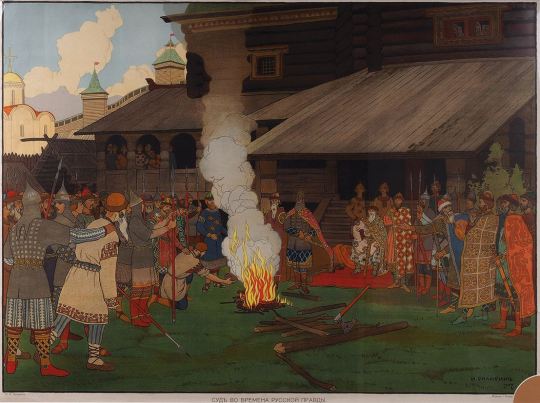
Administering justice in Kievan Rus, by Ivan Bilibin. Source: http://www.vnikitskom.ru/antique/auction/80/34853/
A new Ukrainian state, the Cossack Hetmanate, was established during the mid-17th century after an uprising against the Poles. Despite continuous Muscovite pressure, the Hetmanate managed to remain autonomous for well over 100 years. During the latter part of the 18th century, most Ukrainian ethnographic territory was absorbed by the Russian Empire. Following the collapse of czarist Russia in 1917, Ukraine achieved a short-lived period of independence (1917-20), but was reconquered and endured a brutal Soviet rule that engineered two forced famines (1921-22 and 1932-33) in which over 8 million died.
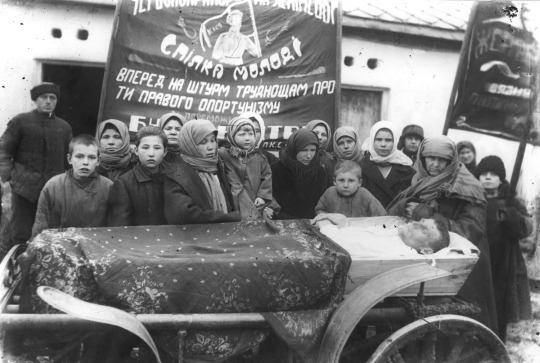
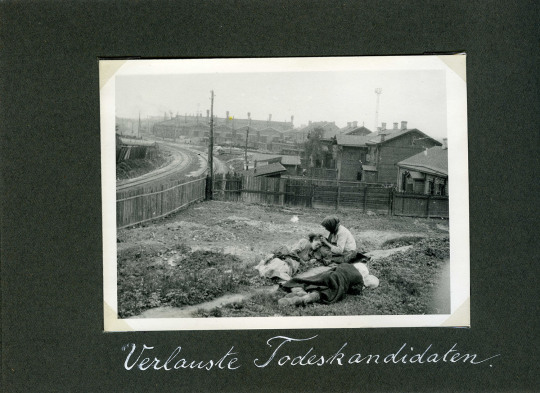

Holodomor, man-made famine that convulsed the Soviet republic of Ukraine from 1932 to 1933, peaking in the late spring of 1933. It was part of a broader Soviet famine (1931–34) that also caused mass starvation in the grain-growing regions of Soviet Russia and Kazakhstan. Photos: https://ukrainer.net/common-lies-about-the-holodomor/
In World War II, German and Soviet armies were responsible for 7 to 8 million more deaths. Although Ukraine achieved independence in 1991 with the dissolution of the USSR, democracy and prosperity remained elusive as the legacy of state control and endemic corruption stalled efforts at economic reform, privatization, and civil liberties.
A peaceful mass protest referred to as the "Orange Revolution" in the closing months of 2004 forced the authorities to overturn a rigged presidential election and to allow a new internationally monitored vote that swept into power a reformist slate under Viktor YUSHCHENKO. Subsequent internal squabbles in the YUSHCHENKO camp allowed his rival Viktor YANUKOVYCH to stage a comeback in parliamentary (Rada) elections, become prime minister in August 2006, and be elected president in February 2010. In October 2012, Ukraine held Rada elections, widely criticized by Western observers as flawed due to use of government resources to favor ruling party candidates, interference with media access, and harassment of opposition candidates. President YANUKOVYCH's backtracking on a trade and cooperation agreement with the EU in November 2013 - in favor of closer economic ties with Russia - and subsequent use of force against students, civil society activists, and other civilians in favor of the agreement led to a three-month protest occupation of Kyiv's central square. The government's use of violence to break up the protest camp in February 2014 led to all out pitched battles, scores of deaths, international condemnation, a failed political deal, and the president's abrupt departure for Russia. New elections in the spring allowed pro-West president Petro POROSHENKO to assume office in June 2014; he was succeeded by Volodymyr ZELENSKY in May 2019.
Shortly after YANUKOVYCH's departure in late February 2014, Russian President PUTIN ordered the invasion of Ukraine's Crimean Peninsula falsely claiming the action was to protect ethnic Russians living there. Two weeks later, a "referendum" was held regarding the integration of Crimea into the Russian Federation. The "referendum" was condemned as illegitimate by the Ukrainian Government, the EU, the US, and the UN General Assembly (UNGA). In response to Russia's illegal annexation of Crimea, 100 members of the UN passed UNGA resolution 68/262, rejecting the "referendum" as baseless and invalid and confirming the sovereignty, political independence, unity, and territorial integrity of Ukraine.
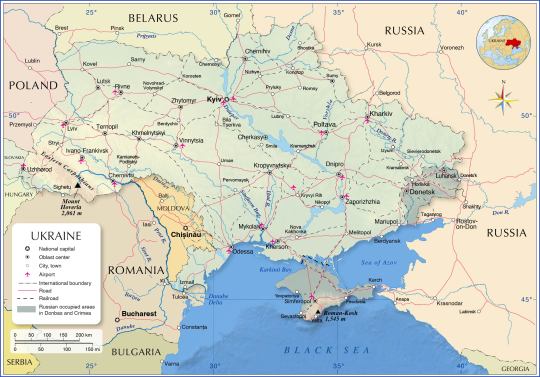
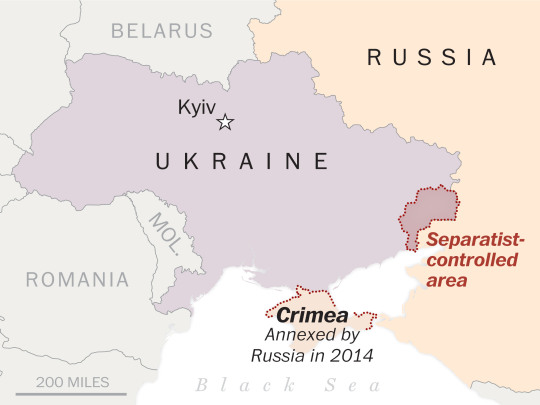
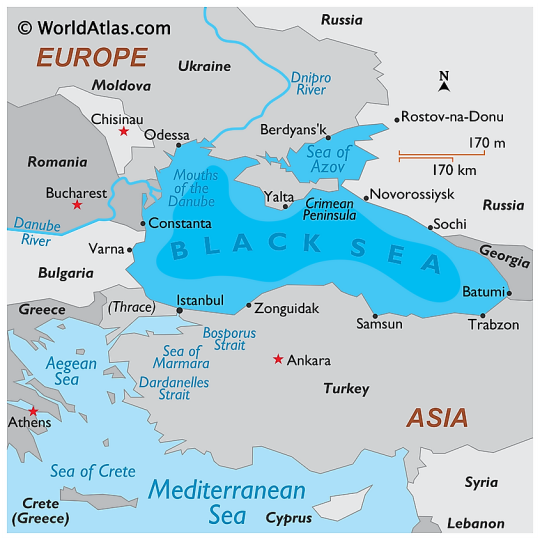
In mid-2014, Russia began supplying proxies in two of Ukraine's eastern provinces with manpower, funding, and materiel driving an armed conflict with the Ukrainian Government that continues to this day. Representatives from Ukraine, Russia, and the unrecognized Russian proxy republics signed the Minsk Protocol and Memorandum in September 2014 to end the conflict. However, this agreement failed to stop the fighting or find a political solution. In a renewed attempt to alleviate ongoing clashes, leaders of Ukraine, Russia, France, and Germany negotiated a follow-on Package of Measures in February 2015 to implement the Minsk agreements. Representatives from Ukraine, Russia, the unrecognized Russian proxy republics, and the Organization for Security and Cooperation in Europe also meet regularly to facilitate implementation of the peace deal. More than 14,000 civilians have been killed or wounded as a result of the Russian intervention in eastern Ukraine.
Geography
Location
Eastern Europe, bordering the Black Sea, between Poland, Romania, and Moldova in the west and Russia in the east
Area
total: 603,550 sq km land: 579,330 sq km water: 24,220 sq km note: approximately 43,133 sq km, or about 7.1% of Ukraine's area, is Russian occupied; the seized area includes all of Crimea and about one-third of both Luhans'k and Donets'k oblasts
country comparison to the world: 48
Land boundaries
border countries (7): Belarus 1111 km, Hungary 128 km, Moldova 1202 km, Poland 498 km, Romania 601 km, Russia 1944 km, Slovakia 97 km
4 notes
·
View notes
Text
KYIV, Ukraine (AP) — Belarus' authoritarian leader on Friday advised exiled opposition activists to “come home, repent and kneel,” while repeating a vague promise to step down if the people “make the decision” for him.
President Alexander Lukashenko made the remarks in his yearly state of the nation address, seeking to underscore his grip on power after suppressing an unprecedented wave of mass protests against his rule.
In 2020 Lukashenko, who has run Belarus with an iron fist for almost three decades, survived the largest and the most sustained wave of mass protests in the country's history. Demonstrations, the biggest of which drew up to 200,000 people, were triggered by him winning a sixth term in office in a presidential election in August 2020 that the opposition and the West denounced as rigged.
Protesters demanded a new election and Lukashenko's ouster and faced a brutal crackdown from the authorities, with more than 35,000 arrested and thousands brutally beaten. Key opposition figures, including Sviatlana Tsikhanouskaya, Lukashenko's main contender in the election, have left the country amid the clampdown, along with thousands of ordinary Belarusians.
Lukashenko on Friday claimed that no more than 10% of the population opposes his rule, and urged opposition activists in exile to come “home, on your knees, groveling.”
“My advice to you: come home, repent and kneel,” Lukashenko said. “It will get worse further on.”
After suppressing the protests, Lukashenko repeatedly aired vague and non-committal promises to step down. On Friday, he stressed that it was up to the people to decide. “You will decide, and this president will retire. If you consider necessary that I do more for this country, you will say so,” Lukashenko said.
Last week, Lukashenko called a referendum for late February, on constitutional amendments that could allow him to further cement his grip on power and remain in office until 2035. The vote is scheduled to be held on Feb. 27.
The amendments bring back limits on presidential terms that had been abolished during Lukashenko’s tenure, allowing a president only two five-year terms in office. However, the restriction will only take effect once a “newly elected president” assumes office, which gives Lukashenko an opportunity to run for two more terms after his current one expires in 2025.
The amendments also confer substantial new powers on the All-Belarus People’s Assembly, a body that nominally represents a wide array of Belarusian society but that in the past has consisted largely of government officials and supporters. The president automatically becomes a member of the assembly and can be elected by the other delegates as its chairman.
Convicted human rights defender Leanid Sudalenka transferred to penal colony in Vitsebsk
Belarus hacktivists target railway in anti-Russia effort
Two more criminal cases filed against activist Alena Hnauk who remains under arrest
Polish border guards report shots fired from Belarusian side
Lithuanian Railways rejects applications of Belarusian companies for transportation of Belaruskali fertilizers
Instead of getting medical aid: Poltical prisoner Yauhen Barouski put in disciplinary cell
Poland accommodated 15K political refugees from Belarus after 2020
Tsikhanouskaya urged Belarusians to come to polls

3 notes
·
View notes
Text

During her reign, Catherine extended the borders of the Russian Empire southward and westward to absorb New Russia, Crimea, Northern Caucasus, Right-bank Ukraine, Belarus, Lithuania, and Courland at the expense, mainly, of two powers – the Ottoman Empire and the Polish–Lithuanian Commonwealth. Under her rule, some 200,000 square miles (520,000 km2) were added to Russian territory.
Catherine made Russia the dominant power in south-eastern Europe after her first Russo-Turkish War against the Ottoman Empire (1768–74), which saw some of the heaviest defeats in Ottoman history. In 1786, Catherine conducted a triumphal procession in the Crimea, which helped provoke the next Russo–Turkish War. This war, catastrophic for the Ottomans, legitimized the Russian claim to the Crimea. Catherine’s triumph in Crimea is linked to a concept of Potemkin villages. In politics and economics, Potemkin villages refer to any construction (literal or figurative) built solely to deceive others into thinking that a situation is better than it really is.
Although the idea of partitioning the Commonwealth of Poland-Lithuania came from Frederick the Great of Prussia, Catherine took a leading role in carrying it out (in three separate partitions of 1772, 1793, and 1795). Russia completed the partitioning of Poland-Lithuania with Prussia and Austria and the Commonwealth ceased to exist as an independent state.
Catherine longed for recognition as an enlightened sovereign. She pioneered for Russia the role as an international mediator in disputes that could, or did, lead to war. In 1780, she established a League of Armed Neutrality, designed to defend neutral shipping from the British Royal Navy during the American Revolution. After establishing a league of neutral parties, Catherine the Great attempted to act as a mediator between the United States and Britain by submitting a ceasefire plan.
Image: Russian Empire in 1792
2 notes
·
View notes
Text
Sarmatism: A cultural immersion that both illuminated and darkened Poland-Lithuania (1569-1795)
Cultural movements and the concepts they espouse can reflect a society’s potential, it can also showcase its limitations, reflecting social tensions. In some cases ideals can burn so bright, it’s social engineers can become somewhat blind and complacent to the reform needed to breathe new life into it. Some ideals can also showcase weaknesses ripe for exploitation by other societies as well. One historical case that could be said to demonstrate this kind of tension is that of the Polish-Lithuanian Commonwealth and the concept of Sarmatism in the 16th and 17th centuries with ramifications into the 18th century and beyond...
Background & Union of Lublin:
-It goes by many names, Poland-Lithuania, Polish-Lithuanian Commonwealth or simply Poland. It was a nation that existed as a bi-federation from 1569-1795 and was the precursor to modern states of Poland and Lithuania. It covered more than those modern nations it also covered parts of Belarus and Ukraine as well.
-Both Poland & Lithuania had a long history of interaction in the centuries prior to their union. With Poland, being made up primarily of the Western Slavic people, the Poles, who were largely Catholic in religious orientation. Meanwhile, Lithuania and Lithuanians were a grouping of various Baltic peoples who officially remained one of the last bastions of European paganism untouched by Christianity, in some pockets well into the 15th century.
-The Poles & Lithuanians were at times antagonistic and other times partners. Poles in the Duchy and later Kingdom of Poland suffered raids from the pagan Lithuanians and other Balts and requested help from the Pope in converting them to Catholicism. This lead to the Northern Crusades from the 13th-15th centuries which saw a gradual conversion of Lithuanians and other Baltic pagans to Christianity. The cross was largely taken up by Germanic religious military orders like the Teutonic Order which became powerful in their conquest of Baltic lands and they began to contribute to the German colonization of Baltic territories.
-This German colonization gradually led to a permanent German presence in the area, one that the fellow Christian Poles felt started to overstep the bounds of their initial mandate, convert the pagans by force of arms. Now the Teutonic Order and other Germanic religious orders were becoming de-facto power players in the area which the Poles sought for themselves.
-1385 saw one the earlier lasting attempts to unify the two nations when Jogalia, Grand Duke of Lithuania converted to Christianity and married Jadwiga, Queen of Poland. This established the Union of Krewo and the Jagilleon dynasty which would rule Poland and Lithuania as separate nations with a common monarch, at least nominally. Though Lithuania would have separate Grand Dukes at times as well. This also lead to the official Christianization of Lithuanian nobility.
-1410 saw the greatest example of cooperation with Polish-Lithuanian forces combined with other Slavic and Turkic Tatar support defeated a Germanic army of the Teutonic Order’s knights at the Battle of Grunwald, also known as the Battle of Tannenberg. This battle would be important in the cultural psyche of later generations of Slavs and Germans who sought to romanticize as part of a centuries long struggle between two broader ethnolinguistic groups in Europe. Another battle fought further east but in the general vicinity would be fought in 1914 during the opening months of World War I between the German & Russian Empires, both seeking to invoke this 15th century battle.
-Over time, Lithuania and Poland signed a number of other unions or treaties that effectively maintained their de-jure separation were in fact both nations were closely interlinked.
-1569′s Union of Lublin, under Sigismund II Augustus, the childless king and last of the senior line of the Jagilleon dynasty evolved the personal union of a shared monarch into a real union between the two. Now both nations shared a common legislature made up of two houses, a Senate & parliament (Sejm). While nominally a joint partnership between Poland-Lithuania, Poland was in fact the dominant power. It had the greater population, the capital, more developed economy and infrastructure. Also cultural Polonization took place en masse among the Lithuanian nobility, with Polish along with Latin being the official languages of country and its nobility. Lithuanian was still spoken among the commoners in the Grand Duchy but over time the nobility increasingly was viewed both insiders and foreigners as “Polish” regardless of ethnicity, this also extended to a lesser degree in the Polish controlled parts of Belarus and Ukraine, where the Eastern Slavs were known as Ruthenians (modern Belarussian & Ukrainians). Though the commoner class remained “Ruthene” and practiced Eastern Orthodoxy.
Sarmatism:
-At its core, Sarmatism is the idea of the supposed origins of the Polish people. That they descend from an ancient nomadic Iranian people, the Sarmatians. The Sarmatians were part of the broader Scythian peoples who were Iranian in terms of ethnolinguistic grouping and ruled over the steppes of Eurasia stretching from Siberia and Central Asia to modern day Hungary in the west. The Sarmatians did become the most powerful of tribal confederations among the Scythians. Like all Scythians they were nomadic and equestrian ruling over the vast grasslands of mostly Ukraine and southern Russia north of the Black Sea.
-The Sarmatians and more broadly the Scythians were mostly known from Greco-Roman sources for most of history, though more recent archaeology and genetic testing has given us a somewhat better understanding of them. They were warlike and practiced horse archery and in the Sarmatian case, developed heavy armor. It was believed the Sarmatians were the descendants of Scythian tribesmen and the warrior women known to the Greeks as the Amazons.
-The truth of whether the Poles descended from the Sarmatians is debated, though the Sarmatians did live in the area of modern Poland and Ukraine and the Romans gave it the name Sarmatia. What is often said is that the Early Slavs who are believed to have lived near the Sarmatians and other Scythians, absorbed the last of them in roughly the first few centuries AD. Sarmatians became culturally and linguistically and eventually genetically subsumed into the Slavs greater numbers.
-While Sarmatians or other Scythian tribes are part of the Slavic makeup, the extent of it is still widely debated and controversial. More pointedly here, the extent to which this directly translated into the modern day Poles, a West Slavic people, is a topic of ongoing discussion that isn’t resolved with certainty.
-By the 16th century, the notion of the Sarmatians being the direct antecedents to the Poles took real stock, mostly among the nobility who saw itself as directly descended from these Iranian nomadic warriors and in some ways not even Slavic. The landed gentry which largely made up the Sejm was called the szlachta and the Sarmatism concept took root primarily amongst them.
-Sarmatism was translated into many forms, took on many aspects and was not uniform in its beliefs or manifestations. Its unifying belief was the Sarmatian ancestry to the Poles.
-Sarmatism affected all aspects of identity for the szlachta. From fashion, funeral rights, art, literature, science, politics, history and plain self-identity.
-As a cultural movement and identity was coupled with a companion political concept within the Polish-Lithuanian Commonwealth, “Golden Liberty” which contained many of the elements of the Commonwealth’s unique political structure and reflected the Polish nobility’s strong sense of self. Both concepts intertwined and became mirror reflections of the broader Polish society. They arose with the cultural flourishing that became known as the “Golden Age of Poland” roughly lasting from 1569 to the 1660′s.
-Golden Liberty as a political system was summed up with the key phrases: “Our state is a republic under the presidency of the king,” Or the “king reigns but does not govern.”
-Its key features made the Commonwealth unique in the 16th-18th centuries among European powers. It had an elected king, one elected by the szlachta. It essentially made the nobility the real power within the nation and the king as their figurehead and sometimes legislative partner. It also required the king to hold a parliament, at least every two years, laws/oath binding elected monarchs to uphold certain laws and privileges' and rights of the nobility.
-The szlachta also had the right of rebellion by force of arms against the king should their rights be threatened by the king’s policies. There was also religious freedom, the right of confederation or of association to band together for a common political purpose. Finally, it granted each member of the Sejm the right of liberum veto or free veto. Which effectively meant if one single member of the body didn’t like a proposal, they could choose to exercise their veto right and strike down the legislation. This practically nullified the idea of majority rule as a check and balance.
-Sarmatism as a political concept early on transcended the multiethnic nobility as they effectively were Polonised, non-Poles who were nobles could still claim Sarmatian roots. In theory this smoothed out ethnic tensions and promoted tolerance. In practice it simultaneously developed an elitist culture, one built somewhat around class with nationalist overtones rather than promoting overt ethnic divides.
-It also promoted a martial tradition, especially of equestrian nature in tune with the Sarmatian-Scythian horse archer tradition. The Poles developed a powerful cavalry tradition most famously their Winged Hussars while the Lithuanians proved to be expert light cavalry troops which was further complimented by the Turkic Tatars, (Lipka Tatars) that moved from the Golden Horde (Turco-Mongols) into Lithuania.
-Sarmatism promoted a host ideals, aside from the somewhat transcendent inclusion of Polonized nobility from many ethnicities it promoted equality among all nobles, no matter their wealth or material possession so long as they were a member of the szlachta. Women were highly regarded as honorable as supposed descendants of the Amazons. Noble pastimes such as horseback riding, hunting and leisurely pacifism were celebrated ideals. Ultimately pushing a preference for a gentrified country lifestyle over an urban based one.
-Conversational culture was regarded as important and something to be encouraged and celebrated. Whole porches were created at estates for people of all background and classes who were passersby to engage in conversation with the owner and family on a host of topics.
-Sarmatism celebrated the good life not only in conversation but large feasts, alcohol fueled parties and accompanied by traditional dances like the polonaise & marzuka.
-Fashion and the arts were touched upon by Sarmatism as well. In fashion, clothing tastes tended to blend oriental and occidental styles. Crimson and scarlet red were ubiquitous. Feathered caps weren’t uncommon and the kontusz (long robe) was a common feature of dress for outer garments.
-The Sarmatists tended to believe they had a kindred culture in the Turks and Tatars both within their own realm and the Ottoman Empire, viewing them as fellow equestrian nomads who were merely misguided by the adoption of Islam. Yet with religious freedom, Islam was tolerated despite the Catholic dominance. Muslims and Jews were sometimes better tolerated than Eastern Orthodox Christians in Polish Ruthenia as well as some Protestant believers. These people were often peasants and regarded as not only misguided but stubborn and uneducated.
-The szlachta also celebrated their “origins” and wealth with oriental architecture in their manors and castles, with eastern architecture, including Chinese influences, along with oriental rugs to adorn their walls and floors being an not unfamiliar sight.
-Even in death Sarmatism played a role, with funerals being elaborate productions and a trend of having coffin portraits made to decorate the coffin and allow for “commune” with the deceased became fashionable as well. These portraits were unique to Baroque Polish art in Europe and provide unique and realistic portraits of the nobility as they lived at the time.
-Politics at end of the day was always intertwined with the Sarmatist culture. They viewed self-government & law & order as sacred rights. Poland-Lithuania could rightly boast that it was unique among its European contemporaries in that it didn’t pursue an absolutist or centralized monarchy. It had relative decentralization, elements of democracy albeit limited to the voting rights of male nobility which at most constituted no more than 15% of the population. Leaving the rest disenfranchised and many to be serfs and the szlachta benefitted from serfdom. Their own self-concept was one that viewed themselves in the tradition of the ancient Greek polis or patrician class of Rome’s Republic in antiquity. They also confidently viewed Golden Liberty as the best system of governance in the world, elitist in more than one sense. One to protected at all costs.
Aftermath & Legacy:
-Poland-Lithuania peaked in the first half of the 17th century and began a long gradual decline due to multiple factors. Ineffectual kings, wars, foreign influence namely from Russian, Prussian & Austrian interference. Changes in the economy, social disorder and political corruption.
-The szlachta and Sarmatism contributed to its decay. They built up its political system which promoted tolerance, strains of which had long existed in Polish politics predating the Commonwealth, such as religious tolerance for Jews and in the Commonwealth era this extended to loyal Muslim Tatars and even some Protestant Christians or foreign religious exiles. There was also promotion of education and the humanities in the sponsorship of renowned universities which promoted mathematics and science. Additionally a renaissance of art and literature among other cultural aspects.
-However, despite all that Sarmatism and Golden Liberty promoted, its designers: the szlachta, also set it motion the very fatal mechanisms which was to end the Commonwealth. Their limitations on the king worked as an effective check on absolutism but their use of the liberum veto, intended as a exercise in equality in practice became a cynically used political device, one that stifled potential reforms from being passed into law. Furthermore, Poland’s enemies in Russia, Prussia and Austria recognized this flaw and using bribes of increased land and money meant they could influence Sejm members to deny legislation which their governments found objectionable. This soon brought divided loyalties among the Sejm, some becoming increasingly corrupt and self-interested, placing foreign influence at the very heart of Polish lawmaking.
-The szlachta in its decentralization had rendered any chance at absolutism which is saw as a threat to its privledged existence. This approach to achieving “equality” in fact morphed into paranoia which spurred resentment towards the szlachta as a class by not extending political rights to other social groups, namely the commoners and in particular the Eastern Orthodox Ruthenians and Cossacks which increasingly sought Russia’s help. This turning of a blind eye on political rights to other social classes within the Commonwealth lead to rebellion and anarchy which drained the economy and increased foreign interference.
-The szlachta had setup a system intended for them and it served them and by extension the country well initially. Ultimately, this same system turned on itself: its very design coupled with changing external factors prevented the reforms needed to sustain and grow the very nation it shaped. Finally, in the 18th century Russia, Prussia and Austria in a series of military actions of varying lengths gradually partitioned the Commonwealth directly into their realms, increasingly the more subtle political bribery gave way to a state so weakened it couldn’t fund an army to defend its borders. Again, by design the miltary had funding issues to prevent the king from using it as a tool against the szlachta and the rights they possessively guarded with increasing suspicion and paranoia.
-1791 saw a long overdue constitution being developed, one that could have corrected the Commonwealth’s flaws and gradually extended political equality to all regardless of economic class. However, it came too little too late, the partitioning powers, namely Russia saw any chance of a revitalized Poland as a threat to their goals and their combined military might proved too much so that by 1795 after a failed military defense, the already reduced Commonwealth was completely annexed. It removed Poland and Lithuania entirely from the map as independent countries until the aftermath of World War I.
-Sarmatism as an ideology and way of life can be viewed in a number of ways and indeed its legacy in Poland has gone through periods of revision casting it in both positive and negative lights. It certainly promoted qualities that can be seen as unique to itself and a system of governance that despite its flaws was ahead of its time. It also help shape a new nation’s identity and one that lasted nearly 250 years. An identity which carries on in the more romantic strains of Polish nationalism to this very day. Taken as a whole, Sarmatism, a concept whose very central claim is a subject of debate could be summed up by the following description from Catherine Leach who translated and edited the memoirs of a 17th century szlachta nobleman named Jan Chryzostom Pasek. Leach says...
"Was the Sarmatian way of life worth preserving? Some aspects of it, no doubt. But because the gentry insisted on jealously guarding its privileges, preventing their extension to other social groups, it doomed the structure of the Commonwealth to atrophy and to the revenge of the lower orders. Sarmatism was an ideological shield against the historical realities which contradicted it at every turn.”





#poland#lithuania#poland lithuania#polish-lithuanian commonwealth#16th century#17th century#18th century#culture#partitions of poland#political history#military history#cultural history#sarmatians#scythians#poles
28 notes
·
View notes
Note
Why Russians (as a whole) are so... yandere towards Ukraine? And I know they were that way long before Putin and 2014 events.
Oh long history there. The super short version is this,
Its important to understand that Russia doesn’t until after the Mongolian Invasion, before that you have a bunch of smaller kingdoms which speak Russian and have Russian institutions, but they don’t necessarily conform to the borders of what we think of today as Russia.
Basically between the late 9th century-early 12th century you have this region called Kievan-Rus. Kievan-Rus is not a nation or a kingdom, its more like a loose cultural region of Confederation and it consists of parts of what we today think of Western Russia, Ukraine, and parts of Belarus.

This is basically the ‘origin point” for Ukraine, Russian, and Belarusian civilization (as traditionally told) and most Russians start there history with this period. So in a vague sense, Ukraine (especially Eastern Ukraine) and Western Russia are part of the same cultural/linguistic unit, even if they aren’t part of the same political unit directly. The heart of this region was the city/principality of Kiev, the capital of modern day Ukraine, which was the center of Russian speaking slavs for awhile. So until the Mongolian invasion, the center of “Russia’ is in fact Ukraine.
Then the Mongols Happen
So the Mongols basically just take over the whole region in the late 13th century, and while they give up some of that territory and split into smaller empires, the Russian part of the empire known as “The Golden Horde” takes over most of what we now today call “Russia” including the city of Moscow. While Kiev was for a time under

So the Mongolian Empire rules over these territories and Kiev breaks away first, and eventually goes off to have its own civilization and history. But it takes a little while longer before what we today call Western Russia to become fully independent, and when it does they spend most of their time trying to unify into a single kingdom.

So by the time Russia really has become like...a thing, like we finally have a Russian Empire, Ukraine has become its own entity, or rather part of the Polish-Lithuanian commonwealth.

But the whole time, Russia still kinda sees Kiev as “their founding homeland” and original capital, and Ukraine as like the origin point of Russia, so they are very possessive of it (also the fact that Ukraine is the breadbasket of the region...that too). Eventually Russia will conquer Ukraine and then the rest of the commonwealth, and starts to move Russians into the region. Once Ukraine becomes fully independent, you have this issue where tons of Russian speakers who are Orthodox Christians still live within the Ukrainian borders, who would like to be Russian now that they are a minority in Ukraine. This is mostly in East Ukraine, while Center/West Ukraine tend to speak Ukrainian and are different types of Christians (Ukrainian Christianity is complicated). And while Ukrainian and Russian aren’t the same language they are...pretty close
The other reason why Russia is supper attached to Ukraine is because if you ever wanted to invade Russia, Ukraine is the perfect place to go from, which is why Russia used to be super protective of the region. Also there is a LONG history of ethnic cleansing in the region, especially during WWII but that is another story.
5 notes
·
View notes